TRANSITIONYEARSTEMSERIES:ENGINEERING



















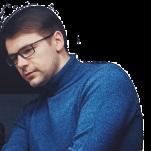


MARGUERITEO’SULLIVAN&SUSANHAYESCULLETON


First published2023
The Educational Company of Ireland
Ballymount Road
Walkinstown
Dublin12
www.edco.ie
A member of the SmurfitKappa Groupplc
© Susan HayesCulletonand Marguerite O’Sullivan,2023
Allrights reserved. No part of thispublicationmay be reproduced,storedina retrieval system,ortransmittedinany form or by any means,electronic,mechanical,photocopying, recordingor otherwise,withouteitherthepriorpermission of the publishers oralicencepermitting restricted copyingin Irelandissued by the Irish CopyrightLicensingAgency,63 Patrick Street, DúnLaoghaire, Co Dublin.
ISBN978-1-80230-109-0
Projecteditor: Donna McCormack
Cover anddesign:emc Design
Layout: Compuscript
Proofreader: Alicia McAuley
Illustrations: Bill Smith, Compuscript, Dusan Pavlic
For permissionto reproduceillustrationsandphotographstheauthorsandpublisher gratefullyacknowledgethe following:
Photos: Adidas, Alamy, Audacity.org, Center Parcs, Cork County Council, Cork Local Enterprise Office, Evercam, iStock/ Getty Images,khanacademy.org, Johnson& Johnson, Maura Hickey, Shutterstock, Sisk,theartofeducation.edu, Twitter, United Nations Sustainable Development Goals (www.un.org/sustainabledevelopment;the content of thispublicationhas notbeenapproved by the United Nationsanddoesnot reflecttheviews of the United Nationsorits officialsor Member States), Wind Energy Ireland.
While everycarehasbeentaken to traceandacknowledge copyright,thepublishers tendertheirapologies for any accidentalinfringementwhere copyrighthasproveduntraceable. They wouldbepleased to come to asuitablearrangement withtherightful ownerineachcase.
Web referencesandQR codesinthisbookareintendedasaguide for teachers. At thetime of going to press,all web addresses were activeand containedinformation relevant to the topicsinthisbook. However, The Educational Company of Irelandandtheauthorsdonotaccept responsibility for theviews orinformation containedonthese websites. Contentand addressesmay change beyondour controlandpupilsshouldbesupervisedwheninvestigating websites.



John Sisk&Son
John Sisk& Sonisaninnovativeinternational constructionandengineering company. An Irish family ownedbusiness, Siskhas officesin Dublin, Cork, Galway, Limerick, Sligo, Waterfordand Portlaoise. Siskfirmlybelievesthatdevelopinga sustainablebusinessmeansgrowingtalent for thefuture. We areproud to support studentsintheirengineeringcareersandhopethat Engineeringinthe World will inspirestudents to beginthatjourney.

Our EarlyCareers Programme covers our core disciplines of Engineering, Quantity Surveyingand Site Management. We have individualsthatstartedwith Siskas graduatesandarenow workingwithusinsenior, technicalanddirectorpositions. To learnmore,scantheQR code.
Michael Kelly, RegionalChief Engineer, Life Sciences& Tech, John Sisk& Son
Johnson& Johnson Ireland
Transition Yearisa wonderfultime to explore new topicsandtakeamoment to reallythinkaboutthefuture andallitspossibilities. Thistimealsoenables you to gainhands-on,funandpracticalinsightsinto the world of STEM.
Havingbeenapart of Johnson& Johnson for over 23 years,itisalways exciting to seewhatthe younger generationsareable to bring to thetable.
Johnson& Johnsonisthelargest,mostdiversifiedhealthcareproducts company inthe world. Operatingin Irelandsince1935,itemploys morethan5,000highlyskilledandmotivatedstaff inthe medtechandpharmaceuticalsectors. Our graduates comefromadiverse range of disciplines,from software,scienceandengineering to business. Johnson& Johnsonlook forward to welcomingmore talentedSTEMleadersinthefuture and watchingthembecomeapart of ourstory.
Leisha Daly, Head of Government Affairs& Policy, EMEA SupplyChain Initiatives & Campusat Johnson& Johnson

Cork County Council
Cork County Council recognisesstaff asa key resource One of thestrategicthemes of our Corporate Planis‘Todeliverourambitionwith continuousinvestmentinour people, focusingonengagement,participation,protection of humanrights,diversity andequality.’ Cork County Councilpromotesthese valuesthroughengagement and communication,enhancestheculture of well-beingand constantly reviews the organisationalstructuresthatwill continuallyproducethebestoutcomes for Cork County Council,itsstaff, itselectedmembersanditsdiverse range of stakeholders.
Of the over 2,600 councilstaff members,nearly250areengineers,includingalmost50chartered and fellow engineerswith Engineers Irelandand75 technicians. Besidesengineers,thereisalarge group of other technicalprofessionals,suchasplanners,architects,quantitysurveyors andscientists. Every year,in collaborationwithlocal colleges,the councilacceptsanumber of students for Summer workaspart of theirthird levelcurriculum. On completion of college,somestudents return to work withusasgraduate engineers. Many progressthroughassistant, executiveandsenior technical grades to becomeseniormanagementstaff later intheircareer.
Cork County Councilisone of the foundingmembers of STEM Southwest.
We hopethatthisbookgivesstudentsaninsightinto thediverse roles available to engineersandthatitencourages Ireland’sfuture engineers to embracethe values of community,equality,diversityandhumanrightsintheircareers.
Sharon Corcoran, Director of Economic Development & Tourism, Cork County Council

Engineeringisnotjustaboutbuildingthings–it’saboutimprovingourlivesin countless ways. Whetherit’shelpingourgrandparentsliveindependently, reducinghow longittakes to get to school, givingustheability to talk to ourfriendswhereverthey areinthe worldor offeringanamazingand fulfillingcareer,engineeringhasthepower to shapeour world for thebetter. We wrotethisbook together,one of us(Marguerite)sharingapassion for engineering,whichignited aninterestinthe other(Susan). Sittingonabench,observingall theengineeringinthe worldaround us, we realisedtheimmenseimpactengineeringhasonourdailylives. We wanted to explore this impactandshowcasethedynamicnature of engineeringinsports,inenergy,inthemeparksand more! We arealso excitedaboutthetechnologythat can complete boringtasksandallow more time for creativity. We’reintrigued by how engineeringcan completelychangehow peoplelearn. Everywhere we look, we canseetheimpact of engineeringdesign. However, there arenumerousmisconceptionsabout engineering. Whetherit’sthebelief thatit’snot anaturalindustry for women,thenotionthatengineersneed to excel at maths,ortheideathatjob opportunitiesarelimited, mythscanbediscouraging. Engineeringinthe World seeks to dispelthese misconceptionsandshedlightonthetruepotential of engineering. It isfull of life experiencesand enables you to walkintheshoes of engineers of differenttypes, workingindifferentindustries. Engineeringinthe World ispackedwithactivitiesdesigned for alearning experiencethatsuits every learningstyle,including:
Numeracy: Usingnumbers to generateinsightsandmakedecisions
Oracy: Creatingpresentationsandputting forwardideas to yourclass
Research: Looking for informationanddescribing yourfindings
Visual: Designingimages to convey amessage
Practical: Applyingknowledgeandskills to reallifesituationsortasks.
We have woveninvideos,interactions,demosandinformationthroughthemagic of QR codes. We hopethat Engineeringinthe World inspires you to view the worldfromanengineer’sperspective. We hopethat by goingonthisjourney of discovery, youwill come to shareourenthusiasm for the potentialthatengineeringhas to offerpeopleall over the world. Thisincludesthenext generation of youngpeoplewhoareeager to tacklethe world’sbiggestchallenges,as wellasthosewho want to explore new placesand expandtheirknowledgeandskills. Additionally, we believe thatengineering canprovidesolutions for thosewhoarebornwith,ordevelopunexpected,disabilities,makinglife easierandmoreaccessible for everyone. Our hopeisthatthisbookwillencourage you to seethe worldthroughalens of possibilityandinnovationandinspire you to pursue your ownpassionsand interestsinthefield of engineering.
Every expertandsuperstar wasonceabeginner. Find yourspark! Enjoy!
Engineeringinthe World started off asa conversation over a coffeein Corkone Friday eveningand two yearslater hasmadeitinto everysecondaryschoolin Ireland. It hasbeenamostenjoyable team effort.
Thisproject wasmadepossiblethanks tothesupport of ourthreesponsors. Johnson& Johnson Irelandplayedacrucial roleinbringingthisproject to life,withspecial recognition toGary Hartnett, ClionaO’Geran, Karen Hennessy, JoannaO’Sullivanand MaireadO’Meara. John Sisk& Sonandall thosewho generously contributedtheirtimein compilingthisbookdeserveourgratitude. We would like to giveaspecialmention to thebusinessunitsinvolvedinthecasestudies,including Ireland East, IrelandCivils,Life Sciences& Tech, Regional Building,Vision Built,and Interiors by Sisk,particularly Michael Kelly.Lastly, weextendourappreciation to Cork County Council,especially Sharon Corcoran and Kevin Morey, whosededication to increasingdiversityinSTEMis reflectedinthisbook.
Thanksaredue to John Murphy, a teacherin Regina Mundi College, Cork, for hisenthusiasm,passion and generoussupport everystep of the way.
Thank youalso to Veronica Walsh, Coláiste Treasa, Kanturk,and AineO’Grady, Coláistean Chraoibhín, Fermoy, for buildingthemomentum of our focusgroups,and to allthepeoplewhoshared theirthoughts,ideasand reflectionswithusonthisjourney.
Thank you to alltheengineering rolemodels featuredinthebook for givingtheirtimeandsupportive voice to why engineeringisagreatcareer.
We wish to expresssincereappreciation to Edco. We have been very fortunateto workwithsuch talentedanddedicatedpeople. Julie Glennon welcomedtheinitiativefromthe verybeginningand saw itthroughwithher colleagues. We want to give Donna McCormack,oureditor,aparticular shoutout,asshebroughther ownenthusiasm,critiqueand reader focusedtalent to her role. We werereallydelighted to have heraspart of the team.
TheSTEM Southwestclusterdedicatedtime,energyandsupport to bringthisbook to life,asthey envisionedtheintegration of STEMin everyclassroomin Ireland. Special recognition goes to Michael LoftusfromMTUand Pádraig Leahy fromPLAS for their contributions.
WhenIfirstasked Susan to explore theidea of working together,in February2022,Ididsonervously,knowingI was comingupwithanideawithnofundsandno resources,just passionandenergy. Despiteallthis,sheimmediatelystarted workingwithme. Thank you, Susan.


To bringthispassionproject to lifehasbeenalongambition of mine,andI wouldnothave achieveditwithoutthehelp of many peoplegivingtheirtimefreelyand generously,including: my partner, Garvan,whosewisdomIsought; James, Alannah and Elvie, my soundingboards; my mother, Mary, for her unwaveringsupportthatallowedme to finishwhatIstarted; thestrongpillars in my family, especially my sisters, Anneand Marie,andbrothers, Eugene, William, Michaeland Patrick; and my friends,whobecamesources of greatinspiration. Thank youall.
A note from Susan
I rememberdistinctly when Margueritesaid to me,‘I’d like to write abookaboutengineeringandI’dlike to write itwith you.’ Fromthatmomenton,sheopenedup myeyes to a world of STEMandengineeringthatIhave foundtruly fascinating. It’s anindustrythathassomuchdynamismandimpact. With that comes responsibility. I feelina veryprivilegedposition because, together with Marguerite, we couldshowcasethe opportunities,skills,modelsandquestionsthatengineers need to consider.
Personally,I want to dedicate thisbook to my husband, Ardle. He isthepersonIturn to witha thousandquestionsaday, thepersonwhohelpsmebeabetter me,thepersonwholistens to all of my storiesalongthe way.
I’msograteful to my own ‘engineersinlife’, my mam, my dad, my brother Conorandthe team we have at HayesCulleton.
Thank you, readers, for bringingthisbooktruly to life.As youopenthepages of any chapter, MargueriteandIare excitedly ready to show youall of what’spossiblein Engineeringinthe World

Engineeringisabroad field that involvesdesigning,buildingand maintaining systems and products to meet specific needsandsolve real world problems. From the cars we driveand thebridges we cross to the technology we use everyday, engineering playsa critical roleinshapingour world. The products of engineering can range from complex machineslikeknee replacements and roller coasters, to everyday objects likelight bulbsandearphones, to digitalapps andspecial effects in films.
• 260,000 peopleareemployedin the Irish manufacturingsector. Irish Businessand Employers Confederation
• 23% of engineeringgraduatesare female.
Engineers Ireland
The word ‘engineer’ hasnothing to do with engines. It isderived from the Latin word ingeniare, which means ‘todevise’ andisin turn derived from ingenium, which means ‘cleverness’.
• 45,000 third-levelstudents areenrolledin STEMfields at any onetime.


IDA Ireland Engineering
Theday to day life of anengineer can vary widely dependingon the type of engineering they specialisein, theirlevel of experienceand theindustry they workin. Engineeringisadiverse field withtheopportunity to specialisein many different areas. According to Engineers Ireland, therearesix main categories of engineering: chemical, civil,electrical,biomedical, mechanicaland technology/software.
STEPS Engineering Your Future (STEPSEYF) isanannual Transition Year(TY) programme hosted by Engineers Ireland in schools to give TY students aninsight into engineering at thirdlevelandas a career.
Chemicalengineersdesign,developandmanagetheprocess of making chemicalsand relatedproducts. They usetheirknowledge of chemistry, physicsandmaths to find efficient andsafe ways to create andproduce new medicines. They alsodevelopnew materials for constructionor manufacturingandfind ways to maketheproduction of chemicals moreenvironmentallyfriendly.

Civilengineersareinvolvedintheplanning,design, constructionand maintenance of thebuiltenvironment,includingbuildings,bridges, roads, airports, watersupply systems,sewage treatment systemsand other infrastructure.Civilengineers work to ensurethatthesestructures aresafe, efficient andsustainable,whilemeetingtheneeds of the community.

An electricalengineerdesigns,buildsandmaintains systemsanddevices thatuseelectricity, electronicsandelectromagnetics. They may work onawide range of projects,fromcreatingnew electronicdeviceslike smartphonesandlaptops to designinglarge scaleelectrical systems for buildings,power plantsortransportation systems. An electricalengineer isalso responsible for testingelectricaldevicesandequipment for health andsafetyrisks.


Biomedicalengineeringistheapplication of engineeringprinciplesand techniques to thefield of medicineandbiology. Biomedicalengineers designanddevelopmedicaldevices,equipmentandproceduresthat helpdiagnoseandtreatdiseasesandinjuries. They also workonthe development of artificialorgans,prosthetics (artificial limbs)and other medical technologies.
Mechanicalengineersusetheirknowledge of mechanics (motion, forces andenergy),thermodynamics(heat,energyand work),materialsscience and otherareas of engineering to create solutions to real worldproblems. They areinvolvedinthedesignprocessfrom concept to prototypes (first versions) to thefinalproduct.

A technology/software engineerisinvolvedincreating, testing andprogrammingsoftware for computers,mobileandfixedline telecommunications,internetservicesandembedded systems. They play a roleinshapingthedigitallandscapeanddriving technological innovation. They are responsible for writing, coding, testingand maintaining computer systemsandthesoftwarewithinthem.

Engineersneedamix of hardskillsandsoftskills to besuccessful. Hard skillsare technicalabilitiesor knowledgethatiseasilymeasurable,e.g. technicaldrawingandprojectmanagement. Softskillsare personal attributesandtheability to getonwith otherpeople,e.g. communication,problem-solving and teamwork. Bothsets of skillsareimportant for jobsuccess. Let’stakealook at alltheskillsan engineerusesonadailybasis.
Designing andplanning Engineersspendtime designingandplanning projects – workingout exactlywhatneeds to be done,creatingplansand selectingmaterials.
Engineersare often facedwith complex problemsthatneed criticalthinkingto lead to creative solutions.
and experimentation
Engineersmay conduct experimentsand testsand learnfromunexpected developments.
Engineers examinethe properties, compositionand behaviour of materialsusing different techniquesand tools. They may needamaterialthat canwithstandalot of heat,is environmentallyfriendlyor canlasta verylong time.
Continuing education
Engineersmuststay up to date withthelatest technology andindustrydevelopments. Thismay involvesitevisitsin different countiesand countries, webinars,educational coursesandlearning onthejob.
Reporting Engineersmust documenttheir work, includingdesignspecifications, test results,meetingsummaries andproject reports. Engineers mightneeddetail for meetings, applying for funding,bringing peopleup to date withaproject, writingabusinesscase for a new innovation, etc.
Engineersmay workwith otherengineers, managers,clients,usersand testers to explore theirplansfrom different viewpointsandensure thatprojectsare completedon timeandwithinbudget.
Designisa crucialaspect of any engineering project becauseit’s whereengineers really get to exercise their creativity and comeupwith innovativesolutions to problems.
As wellasdevelopingnew products, many engineering careersare focusedon makingan existing product ordesign processbetter by finding ways to cut costsor reduce errors. Thedesign phasealso involves working togetherand communicationbetweendifferentmembers of theengineering team.
Look at thetimelinebelow, whichdetailshow engineershave improvedkneejoint replacements


Engineersdesign the model for current knee replacements.
Engineers usedifferentmaterials, methodsandsurgery techniques to improve thedesign of knee replacements Improveddesign allows the person to move better, have greater flexibility andhave a better range of movement.

Engineersinvent a robot to doknee replacement surgery.
What couldbenext?
Researchthree examples of productsthathave been re-engineered improvement)and present your findings to theclass. Below are some you started.
Ballpoint pen
László József Bíró patented theballpointpen (now sometimesknown asabiro) in1938 after becoming frustrated with fountain pens that constantly leakedink.




Bendy straw
Drinkingstraws have beenaround for hundreds of years but in1937 Joseph Friedman patented the world’s first bendystraw, afternoticinghis youngdaughter having difficulty drinking froma tallglass with astraight straw.


Searchonline for successfulengineers.Choose twoandwrite atweetabouteach. Mentionthe impactthey have made. Usethe examplesbelow to help you.
Engineersarecuriousabouthow things workandare resourcefulandcreativeindeveloping solutions to existingproblems. Engineers oftenusemodels to helpwithproblem-solving,innovation orcreativethinking.
• Lean helpsengineersfigureoutwhere wastehappensandhow to cutitout. (Youwill cover thisin moredetailinChapter 2.)
• SCAMPER (Substitute, Combine, Adapt, Modify, Put to anotheruse, Eliminate, Reverse) helps engineers to look at ideas,productsandsituationsinadifferent way. (Youwill cover thisinmore detailinChapter 8.)
• SWOT (Strengths, Weaknesses, Opportunities, Threats) analysishelpsengineers evaluate ideas andproducts. SWOT analysisisuseful for engineersbecauseithelpsthem considerthe strengths and weaknesses of theirprojectsas wellasthe opportunitiesand threats.
Thinkaboutthe followingproblemsandsuggestsolutions:
1. How canelectricitybe generatedwithoutusing fossilfuels?
2. How canabuildingbedesigned to withstandearthquakes?
3. How can we reducetheenvironmentalimpact of transportation?
4. How can we improve foodproduction systems to feedagrowingpopulation?
5. How can we encouragemore youngpeopletostudy engineering,giventhetalentshortage intheindustry?



Problem: How canthelife of an expensive machinepartbe extended?
Solution: Treatitwithheatandthenquenchitsotheoutersurfaceis hardanddurable. Thisprocessiscalled‘inductionhardening’.
Metalbeinghardened
Everyproductbeginswithanideaandavision. For example,ifagroup of architectsistaskedwith designinganew school,they can’tjuststartdrawingblueprintsandmaking constructionplansright away First,they must comeupwithavision of how theschoolwillappear,how many classroomsit willhave,whatkind of facilitiesitwillneed,andsoon. Thisvisiongivesthemastartingpoint to begin creatingtheplansanddesignsthatwill eventuallybecomethefinishedschool.
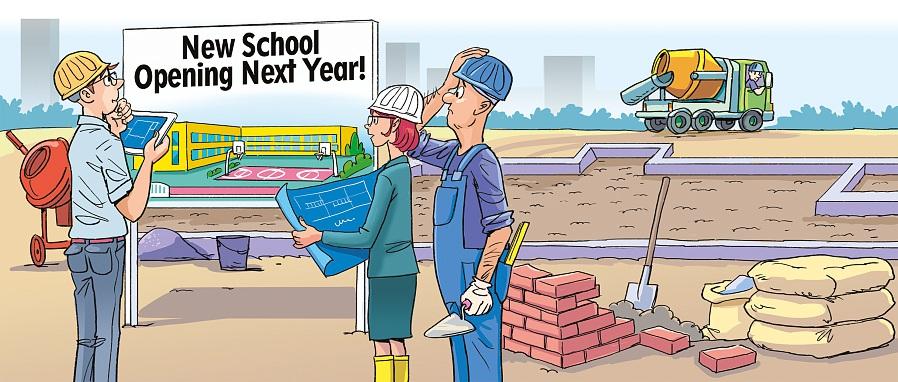 Swirlingcurrentsof electricityheatupthe surfaceofthemetal
Waterjettocoolsurface
Coolersurface
Waterjettocoolsurface
Swirlingcurrentsof electricityheatupthe surfaceofthemetal
Waterjettocoolsurface
Coolersurface
Waterjettocoolsurface
Choosingtherightmaterialsisanimportantpart of thedesignprocess. Materialscanbeanythingfrom woodorplastic to metalor concrete. Eachmaterialhasits own uniqueproperties. It isimportant to choosematerialsthatarefit for purposeandcanwithstandthe environmentthey willbeusedin. Sometimes,engineerscan evencreate their ownmaterials to solve specificproblems. For example, Gore-Texwasinvented to meettheneed for aflexible, waterproof fabric. It remainsahighlypopular waterproofingmaterialwith few significant competitors. When selectingmaterials,anengineer considers factorslike cost,longevity(i.e.durabilityandlifespan of thematerialsbeing considered)andsustainability(i.e.theuse of recycledmaterialsormaterialsthat canbesourcedlocally to reducethecarbon footprint of theproduct). Whetheritisasmallmodelora large scaleproject,choosingtherightmaterialscanmakeabigdifference to adesign’s success.
Draw a word cloud of what comes to mindwhen youthink of engineering. Below aresomequestions to get youstarted:
• What qualities/skillsareneeded by engineers?
• What clothesdo you thinkengineers wear?
• What environmentsdoengineers workin?
Teamworkisimportant to getaproductorservicefromavisionthroughdesignandmanufacture to a quality product. Supplychain refersto theseries of stepsittakes to getaproductorservicefromits original conception to thecustomer, includingallthe companies,processesandactivitiesinvolved.
Everyproduct beginswithanidea andavision of what thatideamight looklike.
Resources referstotools, materials,personneland other things required to carryout work. For example,kneematerialsandan engineerarethemain resources (inputs)needed to make knee replacements (products).
Ideasaredeveloped and tested, considering theirfunction,materialand user experience. A design engineer testsand choosessuitable materials.
Theprojectmanager bringstheidea,the resourcesandthe design together.

Allproductsmustmeet minimumquality standards. Thinkback to themodels thatengineersuse to helpthemwiththeir work.
Take alook at thehistory ofSnapchat below to seeengineeringskillsinaction.
2011
2014
Textconversations and videochatadded
20122013
Android version launched,videosnaps introduced
First versionof Snapchatlaunched 127users

2015
Storiesandsmart filtersadded
‘Minis’ featureintroduced,allowing third-party developerstobuildmini-apps onthe Snapchatplatform,aswellas ‘Spotlight’ feature,ashort-formvideo platformdesignedtocompete with TikTok
2020
Bestfriendemojis, Snapcodesadded
‘Memories’ feature added,allowingusers tosave andshare snapsandstories
2022
New shopping platformlaunched
375milliondaily activeusers
2021
New ‘Snap Map’ feature addedtodesktop,allowing userstoaccessmaps fromtheir computer
2019
New gamingplatform launched,allowingusers toplay gameswithfriends onSnapchat
2016
150milliondaily users
2018
2017
Augmented reality(AR) lensesintroduced, allowinguserstoadd digitaleffectstotheir photosand videos
App redesign,introducing new layoutthatseparates socialinteractionsfrommedia content. ‘SnapOriginals’ series introduced, featuringoriginalcontent producedexclusively for theplatform
Readandsummarise anarticlefrom theengineering blog on Snapchat.
Specifically,engineers oftenusea SWOT (Strengths, Weaknesses, Opportunitiesand Threats) analysis to understandthecurrentsituationand to lookahead. Look at the SWOT analysis for Snapchatbelow. Add your ownidea to eachsection.






Popularity: Snapchatispopular among teenagersand younger adults,which givesitastrongbase of userswhoare likely tocontinueusingtheplatform for yearstocome.
Unique features: Snapchat’s filters, lensesandother augmented reality featuresareuniqueandengaging, whichsetsitapartfromother social mediaplatforms.
Strongbrand recognition: Snapchatisawellknown brandthathasbuilta loyal following.


Competition: Snapchatfacesintense competitionfromother socialmedia platformslikeInstagramand TikTok, whichcanmake itdifficulttoattract and retainusers.
Limiteduserbase: WhileSnapchatis popularamong younger audiences, itmay struggletoappealtoolderusers whoaremore comfortable withother socialmediaplatforms.







Ad revenue: Snapchat relies heavilyonadvertising revenue, whichcanbeunpredictable because of factorslike user engagementandadvertiser demand.
E-commerce: Snapchat hasthepotentialto expandintoe-commerce by allowinguserstobuy productsdirectlyfromtheapp, whichcouldcreateanew revenue streamand keepusersengaged.
























Partnerships: Snapchatcouldpartner with other companiesto offer new featuresor reachnew audiences,whichcouldhelpit stay competitive.
Internationalgrowth: Snapchathas room toexpanditsuserbaseininternational markets,particularlyin regionslikeAsia andSouthAmerica.
Userprivacy concerns: Any perceived mishandlingorbreach of userprivacy could leadtoaloss of trustandusersmigratingto alternative platformsthatprioritiseprivacy and security. Thisthreatcouldhavesignificant implications for Snapchat’sreputation anduserbase.

Changinguserpreferences: Userpreferences andbehaviourscanchangerapidly, particularly among younger audiences,whichcouldmake it difficult for Snapchatto keepupwithtrends.













Regulatory changes: Changestolaws or regulations governingsocialmedia platformscouldimpactSnapchat’s businessmodelandprofitability.
Part of anengineer’sjobis to documentand communicate the workthatisbeingdone,the progressbeingmadeandany challengesin thejob.
When workingonaproject,itisimportant to keeptrack of developmentssothat youcansee yourprogress,spotany areaswherechanges areneededanddiscussthesewith your teamor supervisor.
Reportingcantakemany forms,suchaswritten documents,presentationsor evenjustcasual conversations. It isimportant to communicate clearlyand effectivelysothat otherscan understandwhathasbeendoneandwhatstillneeds to bedone. Reportingisa key part of beinganengineerbecauseithelps to ensurethat everyoneis working towardsthesame goalsinatimelymanner,whilepreventingbigger problems.
Therearemany ways engineers continuetheireducationandlearning. This couldbelearningonthe joborit couldbe attendinga webcast,alectureora conference. Continuingeducationleads to being able to comeupwithnew ways of solvingproblems. Thisiscalledinnovation. Here aresome examples of innovative ways of doingthings:
Digital tools: Many engineersnow useartificialintelligence(AI)andvirtual reality (VR) computer software to helpthemdesign, testandmakeproducts. (YouwilllearnmoreaboutthisinChapter 2.)
Sustainability: Modernengineeringismore awarethan ever of theimportance of protectingthe environmentandensuringdesignsareasenvironmentallyfriendlyandenergy efficient aspossible.
Collaboration: Theinternetand other technology enablesengineers to workwith otherprofessionals fromall over the world. Thisallows for aglobalsharing of new ideas,whichmeansengineerscan makebetter products faster!

Name: AdrianDrogomir
School: AdamstownCommunityCollege,Dublin
Project: AL-energy
Abouttheproject: IgotinterestedinSTEMfromavideoonairaluminiumbatteries.Ienteredthe BTYoungScientistcompetition,gaininghandsonexperienceinexperimentsandplanning.Duringthe competition,thejudgedcommented,‘Aluminium-basedbatteriescouldplayaroleintheprovisionofsustainableenergy.This projectdemonstratesthroughverydetailedexperimentshowthedesignoftheelectrodeimpactsthebatteryperformanceand pointsthewaytofuturedesign.WewereveryimpressedbyAdrian’spassionforthesubjectandhisdetailedimplementationof thescientificmethod.’
ScantheQRcodetowatchAdrianpresenthisproject.
STEM Is a Solitary, Difficult, Boring Field
STEM (Science, Technology, Engineeringand Maths) hasa reputation for beingasolitary, difficult andboring field. However, a BT Irelandsurvey of more than900 workersacross Ireland revealed that most STEM employees were verysatisfiedin theirjobs.
81% of STEM employees were eithersatisfiedorhighlysatisfiedin theirjob.
82% considered their work to be‘inspiring’.
35% said that they found the work they aredoing‘pioneering’. Read theinterview below withLaurie Winkless,an Irish physicistandsciencejournalist basedin New Zealand.

I’ve alwaysviewedengineeringas the practical implementation of physics. Engineers can use their fundamentalknowledge of physics to create things. Some engineersbuild physical things,likebridges, medicaldevices, adhesives, textilesor robots. Otherengineers make intangible things,likesoftwareand mathematical models,or manage complex systems likeelectricity grids, transportnetworks and water infrastructure.
In school,science, mathsandengineeringare usually taught asseparatesubjects,but assoon as youchoose to enter the STEM workforce, you’llsee that they all overlapin ways youcan’t yet imagine!
Honestly,I was rarelyboredinschool (sorry!). But as a physicist,something that I’ve become increasingly aware of –andgrateful for –in recent yearsis my interestinsubjectsmore traditionallyseenas thearts,e.g.historyandlanguages. Sciencedoesn’t existoutside of society –itis very much a part of itandhasbeen woven throughhumanity’sstorysinceday one. Theancient Egyptiansand Incashadsuch adeep understanding of engineeringandscience that they createdstructuresandartwork that still exist. The HarappanCivilisationand the Sumerians created measurement systemsand mathematicallanguages that we continue to use today. InIreland,our ancestors mapped the heavens to anastonishingly precisedegree. Indigenous communitiesacross the worldhave sharedknowledge that has changed the way we treat our environment.
I’ve beenlucky enough to traveland to livein multiple countriesin my life. That, combined with reading widelyand continuing to learn from others–andnot justabout science–have helped to make methe personIam. They have beenjustasinfluentialingranting me ‘success’ as my postgraduateeducationin physics, my many yearsspent workingin research andnow my careerasasciencejournalist.
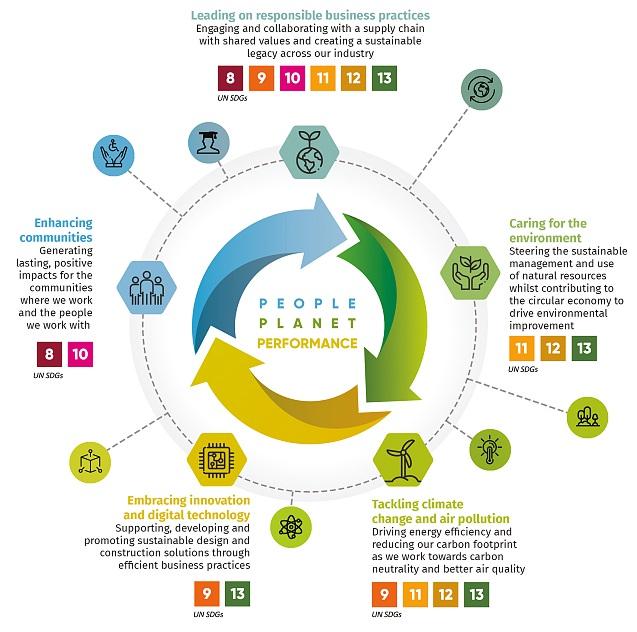

Today, engineersare responsible for bringingsustainabilityinto the core of their work. That might meanbuildingawindturbinesothata company can generateits owncleanenergy, usingmaterialsthatareenvironmentallyfriendlyorcreatingbetter infrastructures to improve people’s dailylives. Engineersusethe United Nations Sustainable Development Goals to helpguidethatprocess.
InDecember 2020 Siskpublishedtheir2030 Sustainability Roadmap,‘Building Today, Caring for Tomorrow’. This roadmapguidesthe company’sjourney towardscarbonneutrality.
Below aresome examples of how Johnson& Johnson Ireland, John Sisk& Sonand Cork County Councilputthe Sustainable Development Goalsinto practice.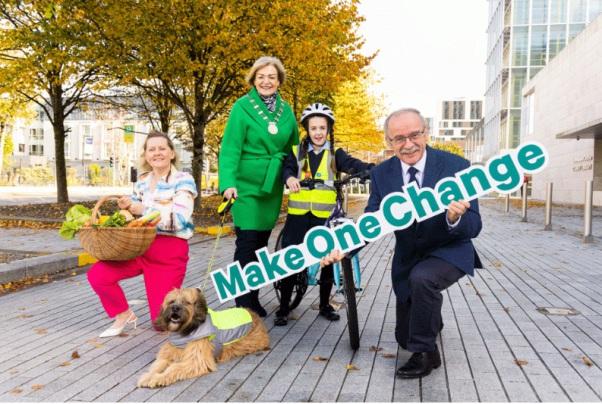
Whenit comes to helping reduce carbon footprint, small changes may feel somewhat insignificant. Butwhen these changes areembraced by society, the combined resultsare staggering.
Climate changeis primarily caused by too muchcarbondioxide (CO2)
in the atmosphere. Small changes can make abig differencein reducingour carbon footprint.
Cut Carbon Monthisjust one of anumber of council initiativesaimed at protecting theenvironment now and in the future. Recent energy efficiency actions undertaken by Cork County Council
includebuilding fabricand heating systemupgrades of threedivisionalbuildings, with fourteenbuildings converted to LED lighting. A majorenergy efficiency programme for publiclighting commences in2023, whichinvolves changingall publiclighting to LED and targetsa minimum of 55%energy efficiency improvement. An assessment isalso underway to determine whichlight commercial vehicles couldbe replaced by electric vehicles. Thestrategy for 2023is to provide at least oneelectric vehicle to each areaandbusiness unit within each councildepartment.
‘Webelieve our first responsibility is to the patients,doctors andnurses, mothersand fathers andall others who useour products andservices. In meeting theirneeds, everything we do must be of highquality. We must constantly strive to provide value, reduce our costsand maintain reasonable prices. Customers’ orders must beserviced promptlyandaccurately. Our business partners must have anopportunity to make a fair profit.’
Johnson& Johnson CredoAt theage of 16I planned to study mathematicalscience,or maybe physicsandastrophysics, at thirdlevel–soI think the factthat Iam anengineer workingin Cork County Council wouldbequiteasurprise to 16-year-old me!
I wouldadviseanyoneinterestedinengineering today to researchthe various fields of engineering. Perhaps try to gainsome reallife exposure to engineering, whether througha work placement in TY or by choosinga thirdlevel course that includes work placements.

Mostdifficultiesor failures teachsomething– whether that’s double-checking your workbefore sendingit to a client orknowing when to aska colleague for help.

In my current role,Iama projectmanager for Cork County Council.I manage and coordinate consultants and contractors for thedelivery of the Flood Relief Scheme. Thisinvolves regularengagementwithmembers of the public andelected representatives to address their concernsandqueriesabout the programme. The scheme for Midletoninteractswith alarge number of other projects in the Midleton areasoI meet regularly with my counterpartson other project teams(housing, traffic and transport, public realmdesigners,architects, conservation,heritage,biodiversity andecology) to ensure a collaborative approach to design.Ialsoliaise withthe Office of Public Works (the fundingauthority for floodschemesin Ireland)in relation to the financing of thescheme. Thereisalot of variety in my day to day work.
DuringschoolIalwaysenjoyed the challenge of the STEM subjects andI wanted to follow a career that wouldallow me to continue to enjoy that challenge, without being tooacademic. However, I’m not sure that I reallydevelopeda passion for engineering untilI wasactually workinganddesigninginfrastructure. Thereisa realsense of satisfactionandachievement in completinga project andinseeingsomething that you have designedactuallybeing constructedand takingshapeon theground.
1 Stateand explain three tasksanengineer mighttypicallydoonadailybasis.
2 Definesupply chain.
3 Name and explainonehardskillandonesoft skillinengineering.
4 State thedifferencebetweena mechanical engineeranda chemical engineer.
5 Carryout a SWOT analysis of Instagram.
6 Explain the concept of quality control.

Lookaround the room. Findand evaluatean existing productthat couldbe improved by engineering. Use the worksheet below to thinkaboutwhat you wouldlike to do,but also the constraints youmight be working with –e.g. limitedspaceoraneed for money.
Name of product:
Dimensions:
Materials:
Purpose of product: Describehow the existingdesignhelps this product’s function.
Sketch animproveddesignbelow andlabelall materials. Briefly explain how the changeshave improved functionandhow theimproved product couldbe manufactured.
• Walkaround theengineering practical roomin your school. Look at thedifferent materialsand writedownthe type of productsthey may be useful for.
• Checkoutthe toolsand machines.
• Note theirnamesand functionsin your journal.
• What are youmost curious to try out?
1 Your list of products that have been re-engineered for improvement.
2 Your list of successful engineers.
3 Yourtweets about successful engineers.
4 Your list of solutions to the problemsoutlinedon page 6
5 Your word cloud of what comes to mind when youthink of engineering.
6 Your summary of anarticle from Snapchat engineeringblog.

New technologiesare continuallychanginghow productsaremanufacturedandproduced. Industrial engineershelp to makemanufacturingandproductionas efficient aspossible. They look atways to save time,money andmaterials by makingtheprocessbetter. Today’sindustrialengineerslearnhow to create new processesand systems to improve manufacturingnow andinthefuture. Smartmanufacturinguses innovative technology like computersimulations, robotics,dataanalysis tools,the Internet of Things (IoT),automationandartificialintelligence(AI). Thiscanmeanmakingmanufacturing faster,cheaper, safer andbetter for theenvironment,as wellasimprovingquality control.

Asanindustrialengineer, Eoin’s jobis to focusonwhatmakesa systemperform efficiently,safely and effectively to produceahighqualityproduct. He has workedina variety of businesses,suchas medicaldevices,electronicsandautomotiveengineering.

Eoinstartedhiscareerinamedicaldevices company thatmanufactured10,000knee replacements everyday to aspecifiedstandardonaproductionline. He workedwitha team to transformproduct designsinto alarge quantity of items,ensuringthey were freefromflaws ordefects. Now he works witha company producingself-driving vehicles.
Eoin workswiththeproductionmanager to ensurethereareenoughpeople to helprunthe productionline,thatthe raw materialis availableandthatalltheequipment is working correctly. Eoin’s jobis to find ways to improve the efficiency of theprocessesand remove waste. In Eoin’s work, everyproblemisanopportunity. Smallideascan oftenbemorepowerfulthanbigideas!

‘1%improvementin1,000thingsisbetter than1000%improvement inonething.’
Tom Peters, Business Management author
Industrialengineers work to reduceany type of manufacturing waste by makingprocesses efficient. Wasteisanythingthatdoesnotadddirect value to theendserviceorproduct. To be efficient means to dosomethingina way thatsavestime,money and resources,withminimum waste. Leanmanufacturingisanapproachdesigned to increaseproductivityand reduce waste. Theseven wastes common to businessandproductionare:

Tip: Themnemonic TIMWOODwillhelp you to remember these!

Leanmanufacturing wasdeveloped by thecar company Toyotaandused to beknownas the Toyota Production System. By makingleanmanufacturingtheguidingprinciple of its processing, Toyotamassively reducedtheenvironmentalimpact of itsoperations.

Avoiding overproductionand wasteled to:

1. Improvedenergy efficiency, resultinginlower greenhousegasemissionsfrom manufacturingplants.
2. Reduced wasteandincreased recyclingandlower emissionsfrom waste.
3. More efficienttransportation,which reducesemissionsfromtrucksand other vehicles. Look at thefiguresbelow, whichshow how Toyota ManufacturingUKhas reduced energyusage, waterusage, wasteinproductionandthequantity of VOC (volatileorganic compounds) releasedfromthepaintingprocesssincethey beganoperationsin1992.
Eoin’s daughter Jessicaisin Fifth Year. Sheisstudying for anengineeringandphysics test. He notices thatsheisbecomingincreasinglyfrustrated. Shesays,‘Ijustcan’tseem to keepanythingin my head!I’vewrittenoutamonth’s worth of notes for bothsubjectsthreetimes.I’mjumpingbetween a textbookandtwodifferent revisionbooksandthey’reall over my roombecauseIhaven’tthetime to organise everything.Idon’tunderstandthedifferencebetweentwodifferenttypes of energyand Ihave to waituntil my physicsclass on Wednesday to findout. Today is only Monday. Some of my notesare inPDF andI want to put everything together,soI’mwritingthemallinto my notebook.I’mwritingdownthe wrongthingssometimes,sothat slows medownandmakesmeneed to check everything. It’s not eventhe firstmid-term of Fifth YearandI’m alreadyburntout. How canIsurvive theLEAVINGCERT?!’

Eoin’s experienceasanindustrialengineerhasgivenhimskillsandtrainingintheleanphilosophy. Theleanphilosophy isnotlimited to manufacturing products for industrialprocesses. Eoin recognisesthatitcanalsobeusedtostreamlinehisdaughter’sstudy techniques. Together, they identifyproblems (areas of waste) inherstudyhabitsand workon efficient solutions. Let’shave a look at whatsolutionsthey comeupwith.
Rather thanproducingnotes over and over by writingthemout multipletimes, Eoinsuggeststhat Jessicasummariseshernotes once. Doingthiswillpushher to becomemore comfortablewith thematerial. He pointsoutthatitiseasy to getdistractedwhen youaresimply repeatinginformation.
Rather thanusingmultiplesources of thesameinformation, Eoin suggeststhat Jessica focusesonthetextbook. Shecanlook at the revisionbooksor othermaterial at alater stageifsheneedsthem.
Rather than wait for herphysicsclass teacher to explaintheinformation, Eoin suggeststhat Jessicalooksonline for a YouTubevideo to explainit.
‘I’vewrittenouta month’s worth of notes for bothsubjectsthree times.’
‘I’mjumpingbetween a textbookandtwo different revisionbooks.’
‘Idon’tunderstandthedifferencebetweentwo differenttypes of energyandIhave to waituntil my physicsclasson Wednesday to findout. Today is only Monday.’
Eoinasks Jessicahow longshespendslooking for thingsin anunorganisedbedroomandhow longit wouldtake to put everythingwhereitshouldbe. Shequickly realisesthathalf anhourspentorganisinghernotes wouldsave alot of time andstress.
‘They’re all over my room becauseIhaven’tthetime to organise everything.’
Eoinasks Jessicawhethershecantype orwrite faster. Shesays,‘Type, for sure!’ He adviseshisdaughter to copy the textfromthePDF over to aneditable document,thentypeupthesummaries fromhernotebookandputthem togetherinonefile. That’s amuch faster way of bringingall of theinformation together.
‘Some of my notesareinPDF andI want to put everything together, soI’mwritingthem allinto my notebook.’
Eoinaskshisdaughter whatshecandoabout writingdownthewrongthings.‘Putmoreenergy into whatI’mdoinganddoitright, rather than worryingaboutwhatI’mdoingwrong,’ shesays He smilesandsays she’s alreadyactingmorelike anengineer!
I’mwritingdownthewrongthings sometimes,sothatslows medownand makesmeneed to check everything.’
Eoinandhisdaughter have achataboutthis. Fifth Yearisa yearwhen youtakeinalot of information. Sixth Yearwill focusonlearning, revising,practising examsandmanagingtheemotionsthat come withthe factthat you’reabout to move on to thenextstage of yourlife. Jessicaisdoingtwo teststhis
week to review whatshehaslearnedinthefirst term of Fifth Year. Rightnow, shedoesn’tneed to putsomuchpressureon herself by stressingaboutthe Leaving Certnext year. By then,shewillhave hadmorestudyand exampractice,soshe willbemore familiar withher subjectsandmore effective at studying. Shejustneeds to takeonestep at atime.
‘It’snot eventhefirstmidterm of Fifth YearandI’m alreadyburntout. How canIsurvive theLEAVING CERT?!’
Lookaround yourschoolorclassroom for evidence of theleanphilosophy inaction. For example:
• You keep yourschoolbagbeside yourdesk. If youleftit by thedoor you wouldhave to walk over to thedoorand wadethroughallthebags everytime youneedsomething. This avoids‘Motion’.
• You get to yourengineeringclassjustbefore itstarts,instead of 30minutesearlier. This avoids‘Waiting’.
ScantheQR code to checkoutthe LeanCase Studiesonthe Cork County Local Enterprise Officewebsitesshowcasinglocalentrepreneursapplyinglean principlesintheirbusiness.

Make apresentation to yourclasson the example you foundmostinteresting.


A key part of Eoin’s jobis to optimisethe efficiency of a manufacturingprocess. He doesthis by looking at a conveyorbelt system(likewhat yousee at ashopcheckout). The conveyorbelt is responsible for transportingboxesfromonestation to another withinthe facility. Eoin wants to evaluate the workdone by the conveyorbelt system to understanditsenergy consumptionand identifypotentialareas for improvement.
To calculate the workdone, Eoinneeds to measurethe force exerted by the conveyorbeltandthedistancetravelled by the boxes. He caninstall forcesensorsonthe conveyorbelt to measure the forceaccurately. He canusesensorsortrackthe movement of individualboxes to determinethedistancethey travel.
Work= Forcex Distance Forceismeasuredin Newtons (N)anddistanceismeasuredin metres (m).
If a force of 3500Ncausesacar to move throughadistance of 50m,how much workisdone?
Workdone=3500×50
Workdone=175,000 Joules
Usingtheequation for workdone, Eoincanmultiplythemeasured force by thedistancetravelled to calculate the workdone by the conveyorbelt system. This informationhelps Eoinassesstheenergy efficiency of the system,identifyany excessiveenergy consumptionandmakeinformeddecisions to optimisetheprocess. Basedonthe workdone calculations, Eoinmay proposeadjustmentssuchas optimisingthespeed of the conveyorbelt, reducingfrictional forcesorimplementingenergysaving technologies. By analysingthe workdone andmakingappropriatechanges, Eoincanimprove the overall efficiency of themanufacturing process, reduceenergy consumptionandpotentiallyincreaseproductivity.

If a force of 5000Ncausesacar to move throughadistance of 100m,how much workis done?
The conservation of energyisone of the key principlesinphysics. Understandingtheprinciple of energy conservation reallyhelped Eoinwhenhejoinedanew project team workingonwindturbines. Eoin couldseethebenefit of convertingthekinetic (moving) energy of windinto mechanicalenergyorelectricalenergy. For example,whenaskydiverjumpsout of aplane,theiraltitude orheightabove thegrounddeterminestheir potentialenergy The force of gravitypullsthemtowardstheground. Theenergy fromtheskydiver’spositionisthen convertedinto kineticenergy (movement). The totalamount of energyhasn’tchanged–butit hasbeen convertedfromone forminto another. YouwilllearnmoreaboutthisinChapter 4.
Total Energy= Potential Energy+Kinetic Energy
The totalamount of energyalwaysstays thesame–itjust changes forms!
Asanobject falls, potentialenergy decreasesandkinetic energyincreases!
Asanindustrialengineer,ensuringsafetyisacrucialpart of thejob,whether working at abungee jumpsiteorapharmaceuticalmanufacturingsitewith dangerous raw chemicals. It involves minimisingtherisk of accidentsandensuring compliance withsafety regulations.


To preventmachinesinvolvedinthemanufacturing processfromcausinginjuries,anindustrial engineerlike Eoinperforms regularchecks to makesureallmachinery isfunctioningproperlyand thesafety featuresare workingasthey should. He might addsafety features,suchasemergencystop buttons.

The principle of conservation of energy states thatenergycan’t becreatedor destroyed,only convertedfrom one form to another.
Therearemany actionsthatmanagers,safetystaff and other teammemberscantakeinthe workplace to helpensurehealthandsafety. For example:

• Putinplace strictsafe workpracticesandprocedures
• Avoidchemical contactwiththe eyesandskin
• Wearprotectiveequipmentwhenonamanufacturingor constructionsite,e.g.safetyglasses,steel toecapbootsandprotectivegloves.

Look at theimagesbelow and explain,in your own words,thehealthandsafetyhazard to be avoidedineachcase.

Two main purposes of healthandsafety signsare to raise awareness of potentialhazardsand to provide clearinstructionsandguidance to ensure the well-being of peoplein the workplace.
A productused to deal with a fire
Electricity-relateddanger
Radiation
Highlyor extremely flammable material
Corrosivesubstance(ifit comesin contactwith livingtissuesit may destroy them, e.g.acid)
Immediate danger


Today, industrialengineersmakeuse of different technologies to planandimplement lean manufacturingandimprove processes. Theseinclude computersimulations, robotics,dataanalysis tools,the Internet of Things(IoT)andartificialintelligence(AI).


Computersimulationsaredigitalmodelsorvirtual experimentsthatallow engineers totestand predicthow a systemordesignwillbehave in differentscenarios. For example,anengineermight create a computersimulation to seehow anew car design wouldperforminacrash. Thisallows engineers to experiment and testtheirdesignsina safe and cost effective way, withoutneedingto buildphysicalprototypes.
Robotics focusesondesigning,buildingand programming robots. Robotsaremachinesthatcan beprogrammed to performa variety of tasks,from simpleactionslike movingobjects to complex actionslikeassemblingpartsorperforming surgeries. For example,the ‘snake robot’developed by engineers at Carnegie Mellon Universityinthe USA isdesigned to slitherthroughtightspacesand navigate complexenvironments. It couldbeused to search for survivorsin collapsedbuildingsor other hazardousareaswheretraditionalsearchand rescuemethodsmightnotbepossible.

Dataanalysis toolsaresoftwareapplications thathelpengineers to analyseandinterpret large amounts of data. These toolscanhelpengineers to identifypatterns,trendsand correlationsindata thatmightnotbeapparent to thenaked eye. For example,ingaming,player behaviourdataincludes informationsuchastheactionsplayers takewithin agame, theirpreferences for certaingamemodes orcharactersandtheirengagementwithdifferent features of thegame. Analysingthisdatacanhelp gamedevelopers to improve thegame experience, increasesalesand retainplayers.

The Internet of Things(IoT) refersto anetwork of devices,sensorsand other objectsthatare connected to theinternetandcan communicate witheach other. For example,imagine you’reanengineer workingonasmarthome system. With IoT technology, youcan connectdifferentdevicesinthehome–liketheheating, lighting systemandsecuritycameras– to a centralhubthatcanbe controlled by amobileapp.

Asengineering weaves togethernew ideas, technologies,hardwareanddata,it getscloser and closer to finding ways thatmachinescanlearnwithouthumaninput.
Machinelearninghappenswhena computer collects examples of thingsthat you want it to recogniseandistrained to recognisethesethingsthroughtheircharacteristics.
For anengineer workingwithAI,itisimportant to be aware of several key themes,including:
• Predictivemaintenance
• Supplychainmanagement
• Quality control
• Economic benefits
• Ethical considerations.
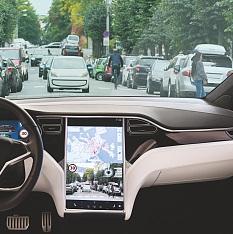
A self-driving car must beable to differentiate betweena traffic light, anoncoming car anda pedestrian crossing the road. To achieve this, engineers firstshow the computer tens of thousands of images of what it wantsit to identify in the future. Then, the computerlearnshow to spot theseitemsin other circumstances.
What ison the road?
What isitslikely behaviour?
Traffic lightStationary
What areits characteristics?
What actionis needed?
Three circles with bulbs Stopif red
Slow ifamber Move ifgreen
Car Likely to move if the traffic light isgreenandstopif the traffic light is red
A certainheight
Fourwheels
A personin the front
Maintainasafe distanceandstay in adifferent laneifit’s comingin theopposite direction


Pedestrian Could cross the road at a pedestrian crossingorany other part of the road

A certainheight and breadth
Avoid at alltimes

AI offersa variety ofof benefitsinsmartmanufacturingprocesses. For example,predictive maintenanceoccurs whenmachinesorequipment ‘tell’humanswhenthey need attention. Industrial engineerslike Eoindesignaprocessor codethatlooks at themachine’stypicalusage,the conditions thatit’soperatinginanda way thattheequipment cangive feedback. For example,acarcan tellthe driverwhenit’srunninglow onelectriccharge orfuel.
Predictivemaintenancehastwoprimary goals:
• Minimisetherisk of failure:spotwhensomethingisn’t workingandimplementafixbefore a failure, e.g.it’sbetter to rechargeorfillupwithfuelbefore breakingdown!
•Examinethedata to seeiftherearepatternssuggestingproblemsoropportunities.
UsingAIinsupplychainmanagementhelps to improve the overallsupplychain.AIcanlook at thedataandanalysethe possibleoutcomes of makingachange.
For example, Eoinis workingonasituationintheself-driving carmanufacturingplant. Thereare fourpeople working ProductionLineA,fivepeople workingon ProductionLineB andthirteenpeople workingon ProductionLineC. What wouldbetheimplication for all of themifhe tookoneperson fromCandanotherfromBandputthembothonA?AIcan analysedifferent factorsandhelp Eoinmakeadecisionthat benefitsthemostpeopleandthefactoryitself.
Smartcameras,whichhave storageandprocessingcapabilitiesbuiltin,alongwithAIenabled software,helpindustrialengineerslike Eoin to designquality inspectionsmore efficientlyand at alower cost.
Thecapabilities of AIare exciting. It bringslikelyeconomicbenefits,butalso ethical concerns.

Remember Supplychain refersto the series of stepsittakes to get aproductorservicefromits original conception to the customer,includingallthe companies,processesand activitiesinvolved.
Automation – Certaintaskscanbedone by robots. Jobs – If robots replace humansin certainjobs, whatnew jobopportunitiescanbecreated for thesepeople?
Smartdecisionmaking –AIcanhelpusmake decisions by looking at muchmoredatathana human could.
Enhancedcustomer experience –Chatbots on websitescananswerthousands of customers at thesametime,enabling customers to getanswersquickly.
Medicaladvances –AIcanhelp to identify thebesttreatment by comparingapatient’s situationand symptoms to datafrommillions of otherpatients.
Researchanddataanalysis –AIcan read millions of pages of text at aclick of abutton andthensummariseit for ahuman to make decisions.
Decisionmaking responsibility – If we relyonAI to summarisedataorcarryout certainjobs,whatif we endupharming othersas a result?
Legalenforcement – Wheredoesthelaw stand ona robot? If aself-drivingcarinjuressomebody becausethereisaproblemwithitsprogramming, whatarethe consequences?
Datasecurity –Asmoreandmore of ourdatais collectedthroughtheapps we use,includingour location,ouremails,our voice conversations,the things we clickon, etc.,therearegreater cyber securityanddataprivacy concerns.

Balance – We need to alwaysmakesureAI works for humans to helpthe world rather thanhurtit.
Register for afreeaccount at OpenAI.com totestoutChatGPT. Thisisa conversationalAI programthat canchatwith you,answer questionsandchallenge assumptions. Askitfivequestions.
Observehow itcan readandanalyse countlessarticlesandwrite a responseinseconds.
Here aresome companiesleadingthe way in smartmanufacturing.

Kinda Technologiesenables companies to create their ownappswithouttheneed for coding. Thismakesdigitisationeasier.
Derya Sousa,CEOand Founder at Kianda Technologies,believesthatsmart manufacturingisagreatopportunity for young people to upskillandprepare for exciting

careers now andinthefuture.‘Robotsarecreatingnew jobs. The younger generationin particularcanblenduniquehumanqualitieswith technicalskillsfromanearly age to help thembeprepared for the exciting roles comingtheir way. They aresettingthemselvesup for successbothnow andinthefuture,’ shesays.

Sousa explainsthatKianda’svisionis to helpthe worldintwo ways – to allow morepeople, regardless of theirprogrammingskills, to beinvolvedinthecreation of technology, and to helpdigitisationandIT teams to increasetheircapabilities to deliversolutionsmorequickly andmoreeasily.
Shesays thatwhatsheismostproud of ishow, with thehelp of theKiandaplatform, delivering technology isbecomingmoreinclusive.‘Icanseethatourcustomersareinthe drivingseat of digitaltransformationprojects,whetherthey have programmingskillsornot.’
Digitalsolutionsareburstingwith opportunitiestochangehealthcareand create thebestpossiblehealthoutcomesand experiences for patients. Johnson& Johnson medicaldevices companiesbring togetherthe power of next generation robotics,dataand analytics,AIandmachinelearning to offer digitalsolutions for healthcareprofessionals and for patients. Theiraimis for afuture where medicalinterventionissmarter,less invasiveandmorepersonalised for patients.
For example,inorthopaedics, Johnson& Johnsonhelpscare teams connectwiththeir patientsusingactionplans,education,direct feedbackanda companionmobileapp. For surgeons, Johnson& Johnson offersdataandanalytics,augmented reality(AR)and virtual reality (VR) toolsthatcanenhancetraining,as wellasdigitalsurgery. Digitalsurgery blendsthebest of humananddigitalandisbecomingthe reality for many surgeons.

Siskhasintroducedanew systemcalled Digital Smart Containers,whichusesQR codes. This systemallows site teams to access projectinformation, review quality checks andmanagetasksinone convenientplace. Theimplementation of this system resulted ina remarkable356%increasein efficiency injust4months. Duringthesameperiod,the overallproduction efficiency,includingquality checks,issue resolution by subcontractorsand workapproval,improved by 21.1%. Moreover, Digital Smart Containers contributed to a44% reductioninpaperusage at Sisk’s offices.
Engineeringisnotlimited to technicalskillsalone. It needs both technicalstrengthsand creativity. Engineersneed to blendscientificknowledge, problem-solvingskillsand creativity to developinnovative solutionsthatimpactourdaily lives.

One example of aqualified engineerwhoisknown for his creativityis James Dyson. Dysonisa Britishinventor andindustrialdesignerwhohas madesignificant contributionsinthefield of engineering,particularlyinhouseholdappliances. Anotheris Ayanna Howard,anaccomplished roboticistandengineerwhohasmadeimportant achievementsinthefield of roboticsandAI.
Name: TahaFareed,JevinJoy
School: ColáistePhádraig,Lucan,Co.Dublin

Project: Exploringapopheniaandpareidoliainmachinelearningandoptimisingforpredictingstochasticpatterns
About theproject: Thisresearch projectsoughttoinvestigatethepsychologicaltendenciesapopheniaandpareidoliain machinelearningmodelsanddeveloptechniquesforimprovingAI’spredictionofdatathatappearscompletelyrandomto ushumans.
Ourprojectwastheculminationoffouryearsofdevelopingourskillsinprogrammingandteamwork.
Wegainedpresentationskillsand,mostimportantly,improvedourproblem-solvingabilities.Workingonnumerouscomplex projectsrequiredconstantcommunication,dedicationandlearning.Tous,problem-solvingandworkingonprojectsisan experienceyoucan’tgetfromanythingelse,andhasthepotentialtohelpchangetheworld.

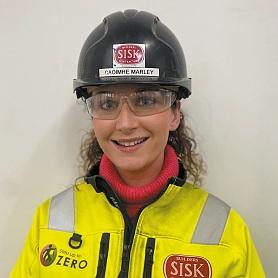
At schoolIloved maths, physics,applied maths, technicalgraphics andart,soIapplied to study architecture. The course wasn’t for me, but Ienjoyed theengineering module,soIdroppedout of architectureand startedstructuralengineeringin Cork Institute of Technology (now called Munster Technological University).
Structuralengineeringis the mathsbehindabuilding, whichensuresitstaysstanding. In college,Istarted theCiviland Structural Engineering Society and foundIloved workingand planning eventswith other people. So,although my courseis mainly focusedon workinginan office,Idecided to do my two work placements onsite, combining my interestsinengineering, planningand workingas part of a team. Istarted working with Siskin2018asagraduateengineerandnow I’m asenior engineer.
I think my 16-year-oldself wouldbesurprisedabout how confident Iam. In school, I wouldhardly raise my hand up to askaquestion, whereas thesedays,I couldbe runninga meeting.
Everyday isdifferent. In my current jobasa concretetesting technicianI first oversaw testing for consistency andstrength. ThenI movedon to thearchitecture fit-out, whichincluded wall construction, flooring,doorsand ceilings. Everyday isdifferent –I work with differentpeopleanddifferent skillsare required.

Froma youngage,I wasinterestedinhome upgrade TV shows like Grand Designs, Property Ladder and Extreme Makeover. My sisterandI would watchhours of these,and they must have madeanimpact, asI’m anengineerandshe’s aqualifiedarchitect.
I thinkone of the maindifficultiesI come acrossisbeinga womanona construction site. My jobtitleis Senior Engineer,butthat’s often thelast role people thinkIhave. The most commonquestionI get askedis whetherIam thesafety officer, and then whetherIamindocument controloradmin.Isuppose that comesdown to the fact that womenare underrepresentedon most constructionsites. My job wouldbe seenas goingagainst thenorm. But nooneshouldbedeterred by this. It’s more than possible for women to carveout agreatcareerin construction.
1 xxx 2 xxx 3 xxx
Describe the role of anindustrialengineer. Explain theseven forms of waste that lean principlesseek to avoid.
3 Define workandenergy. Next, explainsimply thedifferencebetween workandenergy.
4 Calculate the workdoneifa force of 5300 Ncausesa car to move throughadistance of 500 m.
5 Stateand explain the principle of conservation of energyin the context of a cyclist at the top of ahillabout to cycledown to sealevel.
6 Write threesafetyprecautionsadvisableinanengineering environment.

7 What characteristics might asmart camera seeina traffic light, a pedestrianandastopsign?

Choose(A)or(B)below.
A Self-driving cars have the potential to change the way our cities workin the future. Describehow youthinkself-driving cars may impact:

(i) Trafficmanagement
(ii) Theenvironment
(iii) Car ownership.
B Artificialintelligence will play animportant roleininfluencingand increasing productivity in the workplace. Explain the following processesin relation to smart manufacturingin the future:

(i) Supply chain management
(ii) Predictive maintenance.
• Talk to your teacherabout how AI couldbe usedin your engineering practical room to predictthe maintenanceneeds of some of the machines.
• Lookaround your school for ideas of how lean processes couldbeimplemented.
1 Your research about Toyota’s application of lean manufacturingin their engineering processes.
2 Your list of observations of lean principlesinactionin your engineering classroom.
3 Your reflectionson the Corkbusinesses usinglean manufacturing.


4 Yourcalculationsonenergyand work.
5 Your graphical collection of healthandsafety signs.
6 An understanding of PPE.
7 Yourchat with ChatGPT, the OpenAI chatbot.

Examples of goodengineeringdesignareallaround you. The followingaresome commonengineering designs that helpour day to day livesrunsmoothlybut are often overlooked.

Engineers make sure traffic lights keep everyonesafe whiledrivingon the roads inour townsand cities. They also think about how trafficflows duringdifferent times of theday to make sure the traffic lights work efficiently andhelp reduce traffic jams.

For security, youusealockand key for your bike,school locker andhome. Each key has uniqueridgesdesigned to perfectly line upwith ridgesinside thelock. Thelock will only turn when theridgesareinalignment.

Sound Engineershave consideredhow the design of your school,homeand other buildingssuch as cinemasand theatres controlssound to make them more productive and pleasantplaces to be. They have alsodesignednoise cancelling headphones to blockoutunwanted noise.

Doorhandlesaredesigned to be at astandardheight and position to make iteasy for mostadults to openand close doors.


The Longford Forest resortbuilt by John Sisk& Sonincludes466luxury lodgesand30stylishapartments, which canaccommodate up to 2,500guestsin a car-freeenvironment.
Coupled withtheaccommodation, therearea furthereight commercial buildings, which together form the Village Centre.
Guests canenjoy more than100 indoorandoutdoor familyactivities, a range of restaurantsandshopsand the Subtropical Swimming Paradise, Ireland’sbiggestindoor waterpark,as wellas the relaxing Aqua Sanaspa.

At the centre of Longford Forestis the 29.5°C Subtropical Swimming Paradise. It includes wave machines, wild water rapidsanda wave pool.
The Subtropical Swimming Paradise featuresa transparent roof anda glazed curtain walling system to allow maximum naturallight. Naturalquartz stone wasapplied to all walls,along withundergroundheating.
Excellentpre-planning meantthat materials were ordered,storedand distributedand work couldbe carried out onsite efficiently and withminimal waste.
This was followed up by the site team understanding where everynut andbolt was to be positionedor fixedon the project and washelped by how the material was packaged.
(Thinkback to what you learnedabout lean constructioninChapter 2.)
As this wasahigh profile project in the middle of a Coillte forest, there wasahigh awareness by Center Parcsand Sisk of thelocal community and other stakeholders(i.e. the people who wouldbe affected by Center Parcs,such as peopleandbusinessesin thelocalarea).
The Center Parcs Liaison Officer held regular meetings to updateallstakeholderson the progress onsiteas wellasany issues that aroseduring the construction process. These regular meetings were held for theduration of the project.
One year after completion, Siskinstructed their joineryand training centre in Dublin to donate 100birdandbat boxesas part of theirlong term commitment to sustainability at Center Parcs.


Center Parcsin Longford uses cuttingedge technology to optimiseenergy usage, minimise wasteandimprove guest experience. Itslodgeshave smarthome systems that allow guests to control heatingandlighting remotely, while the water park usesadvanced water treatment systems that conserve water and reduce the use of chemicals.
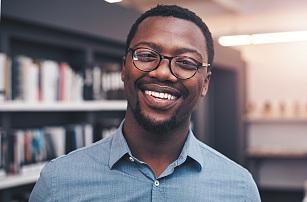
Jack isadesignengineer. Froma youngage,helovedbuildingand creating with 3Djigsaws, wooden puzzles, LEGO, Minecraft and SimCity. He choseengineering, physicsandordinarylevel maths for Leaving Certificate. He went on to study engineeringin college, which offeredhim theopportunity to learnhow to turnhis creativeideas into real products orimprove thedesign of existing products
Jack’s day is very varied. It is filled withcreativity, problem-solving and collaboration. He startshisday by reviewing projects heis workingon,assessingdeadlinesand prioritising tasks. He spendssometimedoing research by browsing throughindustrynews anddesign blogs,and then attendsa team meeting, whereheandhis colleaguesdiscussongoing projects,share progressandaddressany challenges. He worksonideas for design by brainstormingandsketchingideas for new products orimproving existingdesigns. Then, using computeraideddesign (CAD)software,he willstart creating2Dand3D models of theideas, changing them constantly to improve hisdesigns. One of the team’s major projects is the Center Parcs, Longford Forest resort.

Jack needs to study, research anddevelopnew ideasandinnovativedesignsand explore ways of looking at existingdesign problems. He uses the creativity frameworkbelow to helphim. Jackwill talk withthearchitects to develop theinitial concept of the project. They willensure thedesign is feasibleand willbesafe and withinbudget. Jackwillstart thinkingabout how to design thestructural element of the resortbuildingsandbridges,as wellasheating, ventilationandair conditioning.
Source: theartofeducation.edu/2017/08/15/essential-framework-teaching-creativity/




Jackcreatedadesigninspiration folderonhislaptopandsearchedtheinternet for inspirational designsthatarebothfunctionalandbeautiful.
Can younametheinspiringdesignsbelow?
Jackhasaparticularinterestintheuse of lightin design. For example,helovesthe Fountains of Bellagio,Las Vegas,inwhichilluminatedstreams of waterfroman8.5acreartificiallakeare choreographed to dance to asetlist of songs. Theshow uses1,214 waterjetsthatshootstreams of water460 feet into theair, accompanied by 4,792lights.

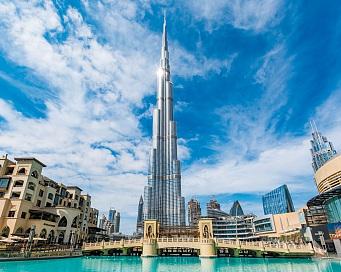
Take aquickvisit to Las Vegason YouTubeand watchthe fountains come to life!
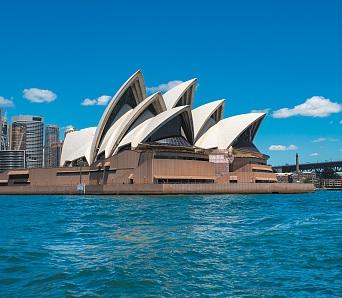 Hint: Paris
Hint: Dublin
Hint: Sydney
Hint:Wicklow
Hint: Dubai
Hint: Paris
Hint: Dublin
Hint: Sydney
Hint:Wicklow
Hint: Dubai
Nearly everybuilding planneeds to be custom designed.As Jackmovesinto thedesignstage,heis aware of the followingdesignand construction processes.


• Thedesignand construction of thebuilding mustmeet the conditions of thesite. For example, you can’tplan to spend€100 million when thebudget for the project isonly€15 million; youcan’tplan abuilding500 metres wideif thesiteisonly300 metres wide.
• Eachproject issitespecific. This means that the planningand construction willbeinfluenced by natural,socialand other conditionssuch as weather, availability of workersandlocalbuilding codes.
• Since theservicelife of abuildingislong, workingout all of abuilding’s futureneedsis very difficult. For example,adesignengineer workingonaschool’sneedsin the1980s wouldnot have factored the requirement for flat screensandbroadbandinto thedesign.
• Because of developmentsin technology, thedemands of the customer and other factors,such as fluctuating costs,adesignengineer must expect and be able to handle changesalong the way.
• Thedifferenttypes of materials that Jackcan useare categorisedin thediagrambelow.
METALLIC MATERIALS
Ferrous (containingiron)
Non-ferrous (notcontaining iron)
NON-METALLIC MATERIALS
Ferrousalloys (combinations oftwoofmore metals)
Ferrous metals (e.g.castiron, wroughtiron)
Non-ferrous metals(e.g. aluminium, copper)
Non-ferrousalloys (combinations oftwoofmore metals)
Example: Wood Example: Concrete Example: StoneBeforeJackandthe teamchooseorpurchaseany materials,they must considerhow different materialssuchasmetals, ceramicsandpolymers (a type of materialthatismadeup of longchains of smallunits) canwithstand externalimpact. To ensurethattheirpreferredmaterialsareup to thetask, Jackandhis team conductaseries of materials tests.

• Fatiguestrength
Fatiguestrengthmeasuresthe‘tiredness’ of a metal,i.e.thenumber of timesthematerial canwithstandachangingloadbefore it breaks. Fatigueisa common reason for materials tofail. It canbeseenin everyday objects. For example,how many timescan youtwistandstraightenapaperclipbefore themetalbreaks? Engineersmust conduct careful experiments to makesurethatthings willnotbreakdue tofatigue.
• Tensilestrength
Thisisthemaximumstretchingthata materialcanwithstandbefore itbreaks. (Hint:think of the word ‘tension’ when remembering‘tensilestrength’.)
• Non-destructive testing(NDT)

NDT isused to detectflaws or faultsthatmay notbenoticeable by simplylooking at a material.
• Penetrant testing(PT)
PTisan example of NDT.
Step1: Preparethesurface of thepart.
Step2: Applyafluorescent penetrant (bright liquidused for inspection) by sprayingitonto a partand wait.
Step3: Remove excessliquidandinspectthe partunderultravioletlight to seeifthereare any cracks.

Carbonsteel canbe produced from recycledsteel,virginsteelora combination of both It is made whenironand carbonarealloyed with smallamounts of otherelements. The construction industry representsmore than50% of the world’sdemand for steel,according to McKinsey, a management consultancy (April2022). Steel CategoryCarbon Content
Low Carbon Steel<0.25% Low carbonsteelsare the most widely used form of carbonsteelandare frequently usedin food cans, pipelinesand vehiclebody components.
Medium Carbon Steel 0.25%–0.6% Mediumcarbonsteelsare frequently used for railway tracks, gearsand machinery partsdue to theirhigh strength, resistance to wearand toughness.
HighCarbon Steel >0.6% High carbonsteelsare usedin cutting tools,springs andhighstrength wire due to theirhigh wear resistanceandhardness.
Engineersarealwayslooking at ways to improve existing construction materials. For example, we referred to polymers earlier. Engineers found that by adding polymers to cement, they couldincreaseitsstrength, water resistanceandability to keep theheat in (also called insulation). Swedish researchershave helped reduce costs by using polymer microspheres 8 millionths of aninchacross, whichoccupy less than1% of the cement

Creation playsa critical roleinengineeringdesign,especially whenit comes to selecting theright materials for a project.
In Chapter 1 you learned that theselection of materialsisanessentialaspect of thedesign process, asit cansignificantlyimpactthe performanceand functionality of the final product. Engineers must consider various factors,such as the physicaland chemical properties of the materials, their cost, their availability and theirenvironmentalimpact,tomake thebest possibledecisions.
Jack andhis team mustuse their creativity and knowledge of materials to determine the most suitableoptions for the Subtropical Swimming Paradise. This may involve coming upwith new ideas, testingdifferentmaterialsandanalysing the results to determine which materials work best for each component of thedesign.
By consideringall of these factorsand using their creativity andengineering expertise, Jack andhis team can create a welldesignedand functional Subtropical Swimming Paradise that meets theneeds of their clients and providesan enjoyable experience for users.
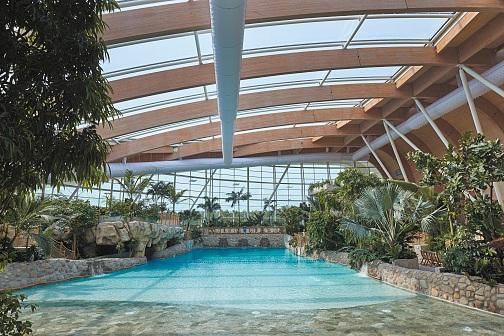
Observethedesksin yourclassroomandthinkaboutwhatdesignimprovements couldbe made to makethemmorefunctionalanduser friendly. Usethe worksheetbelow to think aboutwhat you want to achieve andwhatcanbeachievedwithinany constraints youmay have,suchastime,money andspace.
What do you want to achieve?
What inspires yourdesign?
What constraintsdo youhave?
Sketch yourdesignbelow. Labelallpartsandnamethematerials youused.
Jack consultsalight engineer for specialistadvice. Jack isaskilleddesignengineer, but noengineer canbean expert at everything. Jack knows that focusingon your strengthsdoesn’t have to belimiting. Light engineershave aspecific skillsetthat allows them to workacrossdifferent teamsona wide variety of exciting projects.


Light engineers use the concept of reflection. Light is made up of smallbundles of energy called photons. Lighttravelsasa wave fromitssourceinstraight lines called rays Whena ray of light hits thesurface of anobject, itbouncesback. Thisis called reflection. The two main types of reflectionare regular reflection and diffuse reflection. Regular reflection happens whenlight hitsasmooth, polishedsurfacelikea mirrorand reflects light inonedirection. Diffuse reflectionhappens whenlight hitsa roughsurface,scattering the rays inalldirections. Without reflection, theonly things you wouldseearound you wouldbeobjectsthat giveout their ownlight, likestars– you wouldn’t beable to see your reflectionina mirror, take photographsor watcha movie.
An example of regular reflection: the smooth surface of thestill water of this lake formsa clearimage of theskyand landscape.

An example of diffuse reflection: theripples on thesurface of the water mean that a clearimagedoesnot form.
Scan theQR code to watch a video on the Reflection of Light. Summariseit and give a presentation to yourclasson the key points.
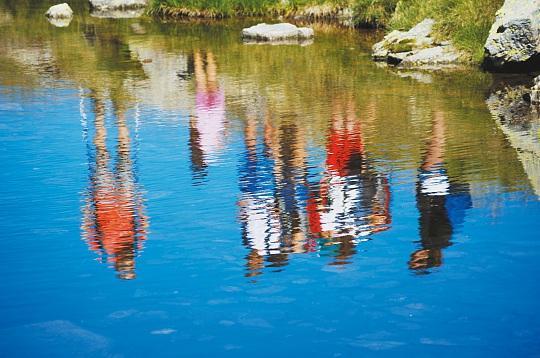
Reflection canbe usedindesign to:
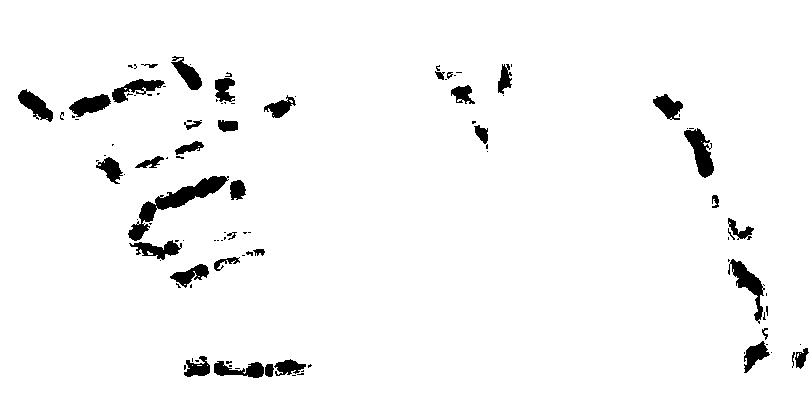
• Make aspace lookbigger
Placinga mirrorina room reflectsthe existingspaceback through the mirror, making the room appearlarger.
• Multiply views
A strategically placed mirror can reflect views from other parts of the room that couldn’t otherwise beseen.
• Introduce views frombeyond
Interior mirrors canbe used to reflect outsideviews to give thenatural feeling of beingoutdoors.


Thedesignbrief for the Center Parcs projectpoints outthat naturallightcanbe used to create a sustainable,energy efficient andvisuallystunningenvironment. Jackpresentstheideasbelow to the team.
Jack is aware that using reflective surfaces, windows andskylights not onlyimproves the resort experiencebut also cuts energy usage and costs.
Lodges, restaurants and the waterparkallhave expansive windows and glass roofs that allow naturallight to floodinto thespaces. This offersabright andinvitingenvironment, while reducing relianceonartificiallighting duringdaylight hours. Thisnot only promotes energy efficiency, but alsohelps to reduce lighting costs.
Reflective surfaces can amplify naturallight.
For example, the waterpark featuresalarge dome roof made of ETFE (ethylene tetrafluoroethylene) film, a translucent material that allows light to pass through while reflectinganddiffusingit throughoutthespace. This createsabright and airyenvironment, evenon overcastdays.

Buildingsand landscapingarealso designed to minimise shadows and maximise thelight, e.g. thelodges arearrangedina staggered pattern to reduce overshadowing, while thelandscapingincludes reflective pools and other features that help to bouncelight around thesite.
As youcansee, Jack’s jobasadesignengineeris very varied. He needs to behighlyorganisedand to understandhow to planand factorin change at thesametime,as wellas communicate with attention to detail.

Writeablogor create a presentation withthetitle‘Engineering Creativity and Design Decisions’. Research examples of successful engineering projects,such as thedesign of the Mars rovers or thedevelopment of renewableenergy technologies. How did theengineers behind these projects approach thedesign process? What decisionsdid they make,and how did they incorporate feedbackanditerationinto their work?

Tinkercad
Step 1:
Think of four different symbols that represent you and yourpersonalinterests,such as family, hobbies, your favouritebandora team you support.

Step 2:
Sketchthe four symbolsinto the templatebelow to create yourpersonal crest.
Step 3:
Builda3D version of your own personal creston Tinkercad.
Optional Step 4:
Printthe crest usinga3D printer. For more detailedinstructions,scan the QR code.
Look at thepicturesbelow of an overhead attraction at Center Parcsin Longford.


1. Outlinethreesafety featuresinthedesign.
2. Identifythemainmaterialsusedand explainwhy they have beenchosen.
3. How couldthesematerialsbe tested for fatigueand tensilestrength?
4. What shouldthechoice of materialsachieve orpreventonthissite?
InIreland, whereonly8.49% of those workingin constructionare women, the government has taken proactive measures to encourage more females to enter the construction workforce – for example,apprenticeship programmes for women, awareness campaignsand the promotion of role models.

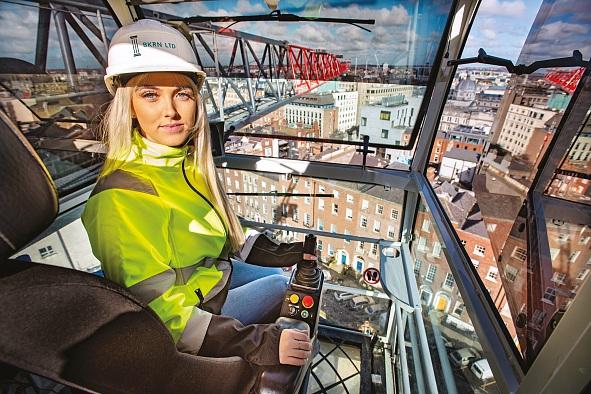
Diversity inany industrybrings fresh perspectivesandinnovativeideas. Femaleengineers can offernew insights andapproaches to problemsolving,enhancing the overall efficiency and effectiveness of construction projects. Different experiencesandviewpointscanlead to improveddesigns,better project management andincreased client satisfaction. Embracing genderdiversity in construction benefits everyoneinvolved.

Name: Orla Murphy
School: Mount Sackville Secondary School, Dublin
Project: The relationship between a bridge’s design and how force and environmental factors affect itsstructural integrity
Aboutthe project: For my project, I made miniature models of typical bridge designs, for example,beam, truss and suspension bridges. I used K’NEX, a kids’ toy used to make things of all shapes and sorts. This material is easily available, which means anyone could replicate my project, if they should wishto do so I investigated how these designs reacted to different resistances totry and understand how they would reactto real world scenarios. I found that the truss bridge performed very well whenexposed to large weights, whichis evident all over the world. Any bridge you see, of any size, withtriangular structures is an example of this My project was highly commended in the BT Young Scientist and Technology Exhibition 2022.
Kate Fahy, BKRN. Photo Courtesy Maura Hickey

DuringschoolIstudiednine GCSEs(Junior Cyclelevel)and threeA-Levels (Leaving Certlevel).I workedhardandachievednine A*sand threeAs (after a few repeatsin my last year)!
Ileft school at 18and went to Queen’s University Belfast to study mathematics and finance. Aftera few fun and challenging years,I washoping to take a yearout to travel,but Covid-19 put anend to that. So Iapplied for a master’sdegreeinCiviland Infrastructure Engineeringandspentthehardest year of my lifestudying at home.I’m very proud to say Iachieved first classhonours inboth degrees through commitment andhard work.
I think my 16-year-oldself wouldbe mostsurprisedabout how far I’ve comethrough simply trusting myselfandsaying yes to opportunities.Inever wouldhave believed that alreadyI’m anengineer,livingand workingin the Netherlands withpeople from allacross Europe and the UK. Trust yourselfand your abilitiesandsay yes!
Difficultieshave taught methat thereisalwaysasolution when you workasa team. Theright solution might not alwaysbe the first plan that comes to mind,but with teamwork, combiningideasand experience, there’salwayssome way to move forward. It’s alwaysbetter to reachout andask for help!
A typical workday involvesspendingtimeboth inside the office preparing workand understandingdrawings,andoutsideon thesite, putting my prepared workinto practice.
I work closely withthesubcontractors everyday andjoindesign meetings, where we discussengineeringideasand plans for the future works of thejob.
Ilike theoutdooraspect of my job,alongsidehavingan office space whenneeded.
Ihad considered teachingand thought alittleabout engineering. It wasn’tuntilI spent aChristmasholiday out onsite with my cousin that I felt my real passion for engineeringbegin to grow. Getting real experienceisdefinitely thebestopportunity to understand where yourpassionslie.
1 Namethree features of thedesignand construction process.

2 Namethree materials used to maximiselight in thedesign of the Subtropical Swimming Paradise at Center Parcs, Longford Forest.

3 What is thedifferencebetweena ferrousandanon-ferrous metal?
4 What isanalloy?
5 Give an example of anon-metallic material.
6 What is thedifferencebetween tensilestrengthand fatiguestrength?
7 What is the carbon weight of mediumcarbonsteel?
8 Explain thedifferencebetween regularanddiffused reflection.
9 Namethree uses of reflectionindesign.
Choose(A)or(B)below.
AUse the creativity framework to designanew attraction for Center Parcs.
BLook at the go-karton theright. Think of threedesign improvements that couldbe made. Explain your reasons for eachone.

Designimprovements:
Draw your improved go-kartbelow:
1. 2.Over thenext24hours, make alist of:
• The places where you notice reflectionand the materials that reflect best
• Examples of beautiful or useful design

• Ideasabout how to improve design
• Observationsaboutwhat materialsare used where.
1 A selection of interestingdesigns fromall over the world.
2 A critical review of your deskin yourclassroom.
3 A summary of the‘Reflection of Light’ video.
4 A 3D printed personal crest.
5 A review of the Center Parcs, Longford Forest case study.


StateandexplaintwoofNewton’sLawsof Motion
Measureacceleration
Applyaproblem-solvingmodel
Examineatableof dataandmake observations
Determinetheappropriatenessofcertainmaterialsfor differentuses
Haveyou everbeenona roller coasterand wonderedabouttheengineeringthat goesinto designing and constructingthesethrillingrides? Haveyou ever consideredthechallenges of makingsure thatthemeparkvisitors aresafe,whilealsocreatingan enjoyable experience? Engineeringplays acrucial rolein thecreationandoperation of themeparks,fromdesigning roller coastersand waterslides to developinginnovative technologies to improve thethemepark experience for allvisitors. Workinginthisfield requiresa combination of creativityand technical expertise. In thischapter, we will explore the exciting world of engineeringinthemeparks, includingthechallengesandopportunitiesthatengineers face andtheimpact of technology onthisdynamicindustry.
Orlaisamechanicalengineer. AfterqualifyingwithaMEngin Electronicswith Musicfromthe University of Glasgow,shestartedhercareerasanacousticengineerwith JaguarLand Rover. Shemovedinto lots of differentareas,like Software-Over-The-Air,whichsendssoftwarefixes to vehicleswithoutthe ownerhaving to bringthem to thegarage.

In hercurrent roleasamechanicalengineerinthemeparksshespendsasignificantamount of time gatheringdataandanalysing results to ensurethesafetyand reliability of theridesshedesigns. Orla also workscloselywith otherengineers,designersandprojectmanagers to developandprogress throughprojecttasks to supportthedevelopment of new themepark experiences.
One of thebiggestchallenges Orla facesisbalancingsafety concernswiththedesire to create excitingandinnovativeridesthatwilldraw visitors to thepark. Sheneeds to behighlyskilledinboth mechanicalengineeringandcreativeproblem-solving.
Orlafindsher workincredibly excitingand rewarding. Shelovesbeingpart of a teamthatcreates experiencesthatpeoplewill remember for alifetime. Orlaalsoenjoys theopportunity to work withcuttingedge technology andpushthelimits of whatispossibleinthe world of themepark engineering.


Roller coastersareone of thebiggest attractions at themeparksaroundthe world. Theirdesign mustbalance excitement andthrillwithsolidengineering,safetyandinnovation. Thedesign of roller coasters,withtheirloops,slow hills, fastdropsandbraking,meansthat roller coasterengineersmust have afirmunderstanding of thelaws of physics.
In particular, Orlausesthe conceptsandcalculations of velocity andaccelerationalotinher workas amechanicalengineer. Velocity andaccelerationare key conceptswhenit comes to understanding motion.
Let’stakethe example of acar.



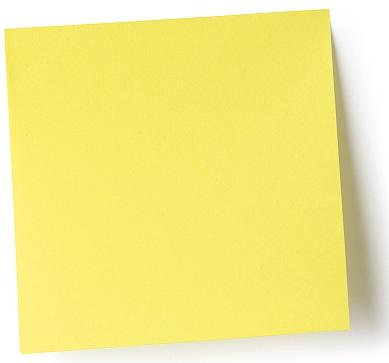
Velocity refersto thespeed at whichthecarismovinginaparticulardirection. Positive velocity is whenacarismoving forward. It tellsushow fastthecarismovinginthat forwarddirection.
Accelerationhelpsusunderstandhow thecar’s velocity changes over time. If youpressthe accelerator,thecarspeedsup,whichmeansit experiencespositive acceleration. If youhitthebrakes, thecarslowsdown, experiencingnegativeacceleration. Thechangesin velocity, whether they are increasingordecreasing,aredetermined by thedevicesthatapply force to thecar,suchasthe acceleratorandthebrakes.

Velocity: Velocity = Displacement/Time. Displacementisthedifference betweeninitialpositionand finalposition,so we must includedirectionwhentalking aboutdisplacement Velocity is measuredinmetrespersecond inagivendirection.
Acceleration: acceleration (changein velocity/ time)ismeasuredin metrespersecond squared.
Force: A forceis anythingthatcauses or tends to cause anacceleration. It ismeasuredin Newtons.
In thedesign of a roller coaster,kineticenergy refers to theenergy of motionpossessed by the coasteras ittravelsalongthetrack,particularly at highspeeds andduring excitingmanoeuvres. Potentialenergy,on the otherhand, comesinto play whenthe coasteris at anelevatedposition,suchas at the top of ahill,and representsthestoredenergythatcanbe converted into kineticenergyasthe coasterdescends, resultingin thrillingdropsand exhilarating experiences for riders.
Remember
Potentialenergy istheenergy thatisstoredinanobjectdue to itsposition relative to some referenceposition.
Thepotentialenergybuilt by a roller coastercarriage goingup thetrack to the top of ahillcan be converted to kineticenergy.
Kineticenergy istheenergy of motionthattakesthecarriage downthehill.
Courtesywww.khanacademy.org(AllKhanAcademycontentisavailable for free atwww.khanacademy.org)Aftera roller coasterclimbstheinitialhillanddescends,itbegins anengineeredcycle of buildingpotentialenergyand convertingit to kineticenergy to propelitthroughtheloopsandhillsthatmake roller coastersthrilling.
Newton’s FirstLaw of Motion,alsoknownasthelaw of inertia, isdirectly relevant to roller coasters. According to thislaw, an object at restwillstay at restandanobjectinmotionwill continue moving at a constant velocity unlessactedupon by an external force.


An objectinmotion tends to stay in motion.

Stationary: At thestart of the journey,the roller coastercarriage isstationary andhasno kineticenergy. However, itdoes have potential energydue to itsheightabove theground. Thehigherthe coasteris,the morepotential energyithas.
Summit: At the top of thehill,the carriagehas reacheditshighestpoint andhasmaximumpotentialenergy. It isabout to experienceasteep drop,whichwill releasethispotential energyand convertitbackinto kineticenergy.
Descent: Thecarriagedrops downthehill, convertingits potentialenergybackinto kineticenergy.Asitspeedsup, itgainsmoreandmorekinetic energyandlosespotential energy.
Ascent: Thecarriage continuesupthehill, usingthekineticenergyitgainedfromthe initialacceleration to reachnew heights.As itclimbs,itgainspotentialenergy,whichis storedasit reachesthe top of thehill. This stageisallabout convertingkineticenergy backinto potentialenergy.
Brakingand return: Thecarriageslows downasitapproachestheend of theride, usingbrakesand othermechanisms to reduceitskineticenergy.Asit comes to astop,ithaslostall of itskineticenergy andpotentialenergyandisonceagain stationary.
Gravityisanatural forcethatpullsthingstowardstheground. Imagine you’re onthe roller coaster andthetracksaredesignedinaspecific way to controlthe force of gravity. Whenthetracksslope downwards,gravitypullsthefront of the roller coastercar towardstheground,causingit to speed uporaccelerate. Thisisbecauseobjectsinmotion tend to keepmoving. Evenwhenthe roller coaster carismovingupthetrackagainstthe force of gravity (whichispushingitdown),itcanmaintainits forward velocity due to itspreviousmomentum. Momentumisthe forcethat keepsanobjectmoving anddependsonmassand velocity. So,gravityplays abig roleinhow the roller coastermovesand experiencesacceleration.

Thetallest roller coasterinthe worldisKingda Ka at Six Flags Great Adventurein Jackson, New Jersey. It goesfrom0 to 128milesperhourinjust3.5secondsandtakes

Thenet forceonanobjectisthesum of allthepushingandpulling forces actingonit. For example,therearemultiple forcesactingonthisbookon yourdesk. The force of gravityispullingdownonthebook;thenormal force of thedeskispushinguponthebook. Thenet force refersto boththe gravitational forceandthenormal forceactingonthebook. If thenet force is zero,thebookdoesn’tmove,asthe forces areequal.


Thesameprinciplesapplywhen you’reon a roller coaster.As youstartthedescentfrom thecrest of thehill,theindividualparts of your bodyarenotpushingoneach otherasmuchas usual. They areallessentially weightless,each fallingindividuallyinside yourbody. Thisiswhat causesthatfunny feelingin yourstomach–that part of yourbodyissuddenly verylightbecause thereisless forcepushingonit.
Thisfullbodysensationis complemented by allsorts of visualcues–theupside downturns,dizzyingheightsandpassing structures.Visualcuesareanimportant part of theridebecausethey tell youthat youare going fast. This isbecause yourbodycan’t feel velocity at all;itcanonly feelthe changein velocity (acceleration) For example,if yousitonaswing andsomebody pushes you, youwillmove. Theharderthey push you,themore youwillmove ontheswingandthemore youwill feel theairon your face
 you45storeyshigh at a90degreeangle to theground!
Kingda Ka
you45storeyshigh at a90degreeangle to theground!
Kingda Ka
Net force refersto all the forces actingonan object.

MeasurementofAcceleration
Apparatus

• Tickertimer
• Tickertape
• Suitablelow voltage AC power supply

• Dynamicstrolley
• Runway
Tickertape Tickertimer
v = Final Velocity
u = Initial Velocity
a = Acceleration

t = Time
s = Displacement

Trolley Runway
1. Set uptheapparatusasshowninthediagram.


2. Connectthetickertimer to asuitablelow voltagepower supply.
3. Allow thetrolley to rolldowntherunway.

4. Thedistancebetweenthespotsincreases,showingthatthetrolley is getting faster.
•••••••••••••••
5. Thetimeintervalbetweentwoadjacentdotsis0.02s,assumingthetickertimermarks50 dotspersecond.

6. Ignoringthedots at the verystart of thetape,chosetwopointsnearthestartandlabel them A andB. Countthenumber of spacesbetween A andB. Measurethedistancefrom A to Bandcallthisdistance s1. If thenumber of spaces you counted wasfive,thenthetime takenis t1 =5×0.02s.
7. Thetime t1 is0.1s.
8. We canassumethatthetrolley wastravelling at constant velocity for ashorttimeinterval. Therefore,



9. Similarly, markoutfiveadjacent spacesnear theend of the tape and find the final velocity v.
10. Measure thedistance s in metres from the centre point of u to the centre point of v.


11. Theaccelerationis calculated by a
12. By changing thetilt of therunway,different values of accelerationareobtained. Repeat a number of timesandadd the results to the tablebelow.
Theaccelerationis measured.
The rate of change of abody’s momentum is proportional to the force that causesitand takes placein thedirection of that force.
Engineers use calculations frequently whendesigning a roller coaster,especially calculations for acceleration. Use the formulaon thestickynoteto calculate the roller coaster car acceleration for Kingda Ka in the USA and Formula Rossain Abu Dhabi.
Acceleration= Changein velocity (m/s) Changeintime (s)
• Kingda Ka climbs45 storeysin3.5seconds, going from0 to 128 miles(206kilometres) per hour at a90degreeangle to theground.
• Formula Rossa goes from0 to 149 miles(240kilometres) per hour in4.9seconds.
ScantheQR code to watchthe YouTubevideo‘Theamazingengineering behind roller coasters’. Complete thequestionsbelow.
1. Whatwasthenickname of themanmentionedinthevideowhopopularised roller coasters?

2. What four key issuesdoengineersneed to considerwhendesigninga roller coaster?

3. How longdoesittake to complete the Steel Dragon2000in Japan?
4. Whichmaterialispreferredinthemanufacture of modern roller coasters?

5. Writedownthreedifferentsafetymechanismsdescribedinthevideo.
6. Namethreephysicsorengineering conceptsshowninthevideo.
Once important conceptssuchas forces,accelerationandenergyhave beentakeninto account, themeparkengineerslike Orlaneed to decideonwhichmaterials to useinthe roller coasterdesign. Look at somethingsthey might considerinthetablebelow.

Material Purpose Reason Example
Steel Thetrackandsupport structure
Steelisstrong,durable andcanwithstandthe forces of a roller coaster inmotion.
Aluminium Trainsorcarsthat carrypassengers
Aluminiumislightweight and corrosion resistant (i.e.,itdoesn’t wear away easily).

ConcreteThe foundation
Concreteisastrong, durablematerialthat canwithstandheavy loadsandvibrations.

Rubberand plastic Wheels,brakesand safetydevices
Rubberandplastic aredurableandcan withstandthe wearand tear of the roller coaster inmotion.
Electronics Sensors,timersand control systems

Electronicscan control the roller coaster’s speed,directionand safety features.

Problem-solvingisa key skill for roller coasterengineers. When considering which materials to use, roller coasterengineers must also thinkabouttheenvironmental conditions where the roller coaster is to bebuilt. The chosen materials must beable to withstandnature’selements. Polya’s Problem-Solving Model canhelp withthis.
An environmental corrosion testisa test that examineshow much metalsandalloyscorrode (wear away) whenoutside. These testsare carriedout inlaboratories. One methodis to measure theamount of corrosion that happens when the metalsandalloys are exposed to weather over a specificperiod of time. The tester removes what has worn away from thesampleand measures the loss of mass, etc. Corrosion measurements usuallygiveonlyan average rate over asignificantlylong timeframe,asit’s not convenient to uselots of samples to get short term results.
Asa theme parkengineer, Orla must work withmaterialsengineers to exposeher preferreddesign materials to rainandsunshineand then testouttheirability to withstand theelements. They analyse theimpact of natureon the materials over different periods of timeand preparea report of their findings.

The reportstates that the rate of corrosion over timedependson whether the materials will be exposed to wet conditions,such as rain, washingandsplash fromnearby water slides. In dry conditions there wouldbe verylittle corrosion. Whilesome wet conditions canbe controlled,such as washing frequency andsplash, weather cannot.
To make aninformeddecision, Orla willneed to findout:

• The pollutant levelin the rain
• Thenumber of times the roller coasterislikely to be rainedon
• Thenumber of hours the roller coasterspends wet
• The average relativehumidity (i.e. theamount of moisture present in theair)
• Theimpact of climate changeonall of theabove.
Orla can use thisinformation to complete thesecondstep by makinga plan.
Step1: Understand theproblem Step2: Make a plan Step3:Execute theplan If theplan fails, return to Step2 andmake a new plan. If the solution isincorrect, return to Step1. Step4: Reflect on the outcomeSource: https://www.met.ie/climate/available-data/monthly-data
* Long Term Averagebetween1981and2010
Examinethetable of dataandanswerthe followingquestions:
1. Whichmonthhasthegreatest total rainfall?
2. Whichmonthhastheleast total rainfall?
3. Which yearhadthehighest total rainfall?
4. Whatwasthe range of rainfall for each yeargivenandwhich yearhadthegreatest range?
5. Whatwasthe average rainfall for August, Septemberand October2020?
6. Go onlineandsearch for thelatestdatasetonwww.met.ie. Comparehow thehighest, lowest, rangesand averageshave changed.
Orla requeststhe following for theappropriate parts of the roller coaster.
1. Addchromium to steel to formstainlesssteel.Chromium,whichmay makeup18% of thealloy, formsaprotective oxide (a compoundmadeup of oxygenand otherelementorgroup)onthe surface of thesteel. Thesealloys are resistant to corrosion. Whilestainlesssteelismore expensive thanordinarysteel,itlastsmuchlonger.
2. Plastic coatings (plasticwith othermaterialsadded)can offer good corrosion resistance for steel. Thiscanhappen by:
• Brushing protectivesubstancesonto thematerial
• Spraying plasticpowderonto heatedmetal
• Hotdipping (dippingthemetalinto ahotliquidbath of plastic)
• Dip coatinginafluidisedbath.
3. Metal coatings offer very good corrosionprotection. They aremoredurablethan othersolutions. Coatingscanbeapplied by hotdipping,hotmetalsprayingand othermethods.
4. Paintthematerialswithrust-stoppingpaint. Thebestpreparations containalot of zincor aluminiumasmetalflakes. However, they may notbe very effectiveand could fail aftera few years,sothisisonlyusedwhen othermethodsaren’t availableorpossible.
Orlaneeds to constantlymonitorwhetherthesemethodsare workingasthey expected. Sheneeds to observeany unexpectedchanges,suchasthe effects of climate change. Shealsoneeds to be aware of the availability of better materials, technologiesandideasfrom otherthemeparks. Shemeetswith her team everymonth to review developmentsandoptions.
Thereareseveralthemeparksthatareusingengineeringprocesses to becomemore sustainable.
Liseberg, Swedenis certified for its eventsustainability management,whichincludesplantbasedmenusinits restaurants.71% of employees commute to andfrom workusingsustainabletravel.
Walt Disney World Resort,USA isknown for its focus onenergy efficiencyand conservation. Theparkhas implementedseveralsustainablepractices,including recyclingand composting,using renewableenergyand water conservation. They alsohave an exhibitdedicated to showcasingsustainable technologiesandpractices.
PortAventura World, Spainhasdevelopeda sustainabilityplanthatincludesmeasuressuchas waste reduction,energy efficiency andsustainablemobility. They alsohave severalinitiatives to promote biodiversityand conservation of natural resources,withthe following results:
•97% waste recovered
•93%singleuseplastic SKUs (stock keepingunits) eliminated
• Waste reducedfrom4,075 tonnesin2019 to 2,708 tonnesin2021.
Examinethe Cork County Counciland Sisk Sportand Leisure Projectslistedonpage70and consider:


• How engineersturnedthesesitesintotourist attractions
• Thedecisionsengineersneed to make regardingthe conceptsinthischapter (i.e. corrosion resistance at Mallow Castleorthe velocity of Dursey IslandCableCar).
• A problemthatmay have arisen for eachsite. Then,chooseoneproblemandput itthrough Polya’s Problem-Solving Model.
Scan the QR code to learn more about Cork County Council attractions.
•Camden Fort Meagher
• Dursey IslandCableCar

• Cobh Heritage Centre
• Harper’s Island Wetlands
• Michael Collins House
• Mallow Castle
• Mizen Head
• Spike Island
• Skibbereen Heritage Centre
• YoughalClock Gate Tower Dursey Island Cable Car

Scan the QR code to learn more about Sisk’siconicsportandleisure venues.
• Aviva Stadium


• Royal Artillery Barracks
• Croke Park
• The Curragh Racecourse
As we learned at thebeginning of thischapter, Orla’s passion for engineeringledher to pursueaMEngin Electronicswith Music at the University of Glasgow. After completingher degree,shestartedhercareerasanaudioengineer at JaguarLand Rover, where she tested andfinetunedthesound systemsintheircars to create thebestpossibleaudio experience for driversandpassengers. Her workinvolved everythingfromensuringtheclarity of Ed Sheeran’s musicthroughthespeakers to perfectingthesound of thewindscreenwipers! Although Orla’s previous experiencemay notseemdirectly related to roller coasters,her backgroundinengineeringandsounddesignishighlyapplicableinthethemeparkindustry. Mechanicalengineers workingon roller coastersneed to have athoroughunderstanding of how theride’s various systemsand componentsinteract to create asafe and exciting experience for riders. They alsoneed to ensurethattheride’s sound effectsare synchronised withthe coaster’smovements to enhancethe overall experience.
The relationshipbetweenartandengineeringhasalonghistory. Leonardo Da Vinci wasan accomplishedengineerandinventoras wellasapainter. Hisabilitiesasanartistenabledhim to draw accuratemodels of hisinventions.

Name: FionaO’DonoghueandKatieO’Donovan
School: Beara CommunitySchool,Castletownbere,Co.Cork

Project: MusicWise–themusicnotescannerapp
Abouttheproject: Developedtohelp peopleplaymusicbyear,theappautomaticallyscanssheetmusicnotes, identifieseachnoteanditslocationontheinstrumentandplaysasampleofthenote.Italsohasinteractivegamestohelp improveaperson’sabilitytoreadmusicandtraintheirear.
Therewasalotofresearchneeded.Welearnedwhatwasinvolvedinmakinganappandthecostofit.Wefullydesigned thefunctionsoftheappbutdidnothavethefundstobringittofruition.Throughourresearchwealsolearnedaboutthe prosandconsoflearningtoplaymusicbyearandlearningtosightread.



Ihave alwayshada curious mind. In school, my favouritesubjects were maths, physics, chemistryand music.I founda course at the University of Glasgow that combined my interestsinscienceand music. The classes were all practicalandapplied to reallife problems. It was fun and challenging.Igraduated with a MEngin Electronic Engineeringand Music.
I thinkI wouldbesurprised to know how much Ilove workinginengineering! WhenI wasdeciding what to study, I wasstillabit unsure ifengineering wasright for me orif Ishouldbe goinginto scienceor maths. But Iamsohappy I choseengineeringbecause the workissointeresting,andIhave travelledand workedall over the world.Iknow I have alotmore exciting things to come in future!
The primarydifficulty Ihave facedhasbeen that, at certain points,I was ready for agreater challenge, changeoropportunity but feltabitstuck. But some of those periodshave taught methe mostaboutwhat I want inajoband careerandhave made me re-evaluate my direction.
Thishas changed vastly year to yearand project to project. Asanengineer, most of my projects have lastedabout one to two years,so therehasbeenalot ofvariety asI followed the projectthrough fromstart to finishor whenI moved to somethingentirelynew.
Earlyin my career, my work focusedon testing,gatheringdata,analysing resultsand progressing through projecttasks to support thedevelopment of anew product.I felt real ownership of the final product and proud of my contribution to certain parts of the product.
In thelast threeor four yearsIhave worked more inengineering management,which is to do withtransformation projects, what processes the teamsare following,sharing best practices,optimisinghow weworkorimproving systems,looking at overall department goalsandhow they areachieved.
Iloved thinkingaboutproblems people face andhow they overcome them. WhenI was 16,Ientered the BT Young Scientist Competition. My projectcame firstin the maths, physicsand chemistrysection of the competitionandI wonaspecial award from the Institute of Physics. This really convinced methat Ihad therightcapability to workin scienceandengineeringandspurred me on to take physicsand chemistry at Leaving Certlevel. That wasgreat experience of doinga projectfromstart to finishand getting a chance to present my work.Ihighly recommend people try abig project at school,either througha competitionorarising fromabusinessidea.
1 Define force.
2 How is forcedifferent to net force?
3 Differentiatebetween potentialandkineticenergy.

4 Stateand explain two of Newton’s Laws of Motion.
5 If the force of gravity is pushinganapple with a force of 10 N,then:

(a) What is thedirection of the force of gravity actingon theapple?
(b) What is thedirection of the force provided by the table theappleis sittingon?
(c) If thenet forceonanappleisn’t zero, what happens to theapple?
6 Calculate theacceleration of:
(a) A car that moves from30km/h to 60km/hin1 minute
(b) A cyclist that moves from20km/h to 28km/hin15 minutes.
7
Number thestepsbelow inline with Polya’s Problem-Solving Model:
• A studentthinksabout how longit tookhim to figureouttheanswer and figuresout abetter way to try nexttime.
• A student hasdifficultyunderstanding thedifferencebetweenspeed and velocity.
• A student looks up YouTubevideos for explainers.
• A student considers talking to his teacheraboutthe problem,looking at YouTubevideosandborrowinganotherbookin thelibrary.
8 State whether plasticorsteelis more durable.
9 Describeenvironmental corrosion testsin your own words.
10 Outline fourmethods of improving corrosion resistance.
11 Explainhow steelbecomesstainlesssteel.
Choose(A)or(B)below.
A Use the Polya’s Problem-Solving Model to buildasmallscale roller coaster using materialssuch as cardboard, paper andstring. This project involves:

• Understanding the problem (designinga roller coaster that issafe and fun)


• Devisinga plan
•Carryingoutthe plan(building the roller coaster)
• Evaluating thesolution (testing the roller coaster for functionality andsafety) with aballbearing.
Scan the QR code for someinspirationonbuilding your model.
BScan the QR code to examine the roller coasterdatafrom the Roller Coaster Database.
(i) Use thedata to create and compare graphsand visual representations of aride’s movements, forcesandhistory.
(ii) Use thedata to study the geometry of roller coaster tracks. Analyse theanglesand curves of different tracks to better understand the principles of geometryandhow they apply to roller coasterdesign.
Use Polya’s Problem-Solving Model to solve the problems youmight have if you were to take onany of these projects asanengineer.
1. Designinga roller coaster that incorporates key engineering principlessuch as Newton’s Laws of Motionand the principles of mechanicalengineering.
2. Developingaride control systemthat usessensors to detectthe positionandspeed of theride vehicle,and then uses thisinformation to control theride’s movement.
3. Designingasafety system for a roller coaster that includes featuressuch as emergency stops,safety restraints andbackup systems.
4. Analysingride performance usingdata collected fromsensors,and then making recommendations for improvements to theride’s design.
5. Developinganew attractionand theengineering systems required to bring the concept to life,including everything fromride mechanics to special effects andlighting systems.
1 An experiment verifyingacceleration.
2 Calculations of velocity andacceleration for different roller coastersaround the world.
3 Informationon roller coasterengineering froma YouTubevideo.
4 Data analysis of rainfall to helpdetermineandsolveengineering problems.
5 Application of the problem-solving model to the Cork County Counciland Sisk Sportand Leisure Projectschallengesandopportunities toturnsites intotourist attractions.



Peopleall over the worldplay sports for exercise, to meet others, for wellnessand for enjoyment. Many athletestrainandplay at a competitive level aspart of regional,nationaland worldsquads. An athlete’s sportingperformancecanbeinfluenced by a variety of factorssuchasdiet, hydration,sleep… andengineering!
Engineeringcanhave asignificantimpacton sportingperformance. By applyingtheprinciples of science,mathsand technology, engineerscan designequipmentand facilitiesthatenhancean athlete’s abilitiesandimprove theirperformance. For example,engineerscan:
• Develophigh techrunningshoesthat reduce impactandimprove running efficiency
• Designtraining facilitiesthatsimulate different weatherandenvironmental conditions,helping athletesprepare for various competitionscenarios
• Developinnovativesolutionsthatpushtheboundaries of humanperformance by applyingthe mechanics of thehumanbodyandthephysics of sportsmovements.
A sportsengineer workswithinthesportsindustry to solve complexsports relatedproblemsusing engineeringandscientificprinciples. Sportsengineers workwith companies to helpmakeplaying sportssafer, help athletes to perform to theirhigheststandardandimprove equipmentperformance. Sportsengineerscanadviseon:
• Sportingequipment,e.g.timing systems
• Sportclothing,e.g.protective gear
• Tools for measuringandanalysingan athlete’s performance,e.g.timersandheart rate monitors
• Sportingenvironment,e.g.the temperature of aswimmingpoolandgradients for cyclists.

Thematerialsusedinsportingequipmenthave animportant role to play insportingperformance. Design,engineeringandsustainabilityhave resultedintheuse of new materialsintheproduction of innovativesportingequipmentandproducts. Let’s considersome examples of how engineersthink aboutmaterialsindifferentsports.
Hurley materials: Carbonfibreandbamboo
Thesematerialsareusedbecausethey arelightweightandstrong,allowing for amorepowerfulswingandgreater control over theball. They have amore consistentflex,whichcanhelpto generatemorespeedandaccuracyinthehit. Carbonfibrecanalsohelp to reducethevibrationinthehurley whenhittingthe ball,makingitmore comfortable for theplayer to use.

Swimwearmaterials: Nylon,spandex

The goal of swimwearengineeringis to use materials that minimisedragin the water (i.e. the force that resists them moving forwardand makesit more difficult to swim efficiently). Speedo partnered withNASA on the LZR Racer swimsuit, which uses very fine microfibres of nylonandspandexinahigh-density weave. Testsshowed that it reducedskin frictiondrag by 24%. It also usesa Hydro Form Compression System that allows theswimsuit to cling to thebody,similarly to how a corset does. In fact, allbut one of theswimmers whoset recordsin the 2008 Beijing Olympics wore the LZR Racer.
Saddlematerials: Leather, nylon,suede, fibreglass


A showjumper wants thesaddle to bea perfectfit on thehorse’s back when jumpinga fence. This means thesaddle fitstheshape of thehorse’s backas wellas matching therider’sstyle to ensure balance, comfortand maximum performance.

Helmet materials: Polystyrene foam
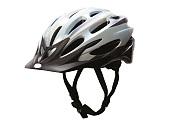
Cyclinghelmetsshouldbe comfortable. They must alsohave goodenergy absorptionso they reduce theamount of energy transferred to a cyclist’s headin the event of anaccident andlowering the chances of seriousinjury. Polystyrene foamisa crushable foam that is very effective at doing this.

Sam isasportsengineerspecialisinginsports footwear. Wellengineeredsports footwear canhelp athletes to improve their performance. For example:

• Cycling shoes aredesigned to increase the efficiency of power transfer from the cyclist’s feet to the pedals. Thisisachieved throughastiffsole that givesastable platform for the foot, which, in turn, reduces theloss of energyduringeach pedalstroke. Thishelps cyclists to maintain their speed for longer periods, cycle fasterand resisttiredness.
• Soccer boots, GAA boots and rugby boots areengineered to providegrip, tractionandsupport to help playersrun faster, cover more groundand make quick turns.

• Running shoes improve running efficiency by reducing theenergyneeded to run. Thisleads to higherspeedsandlongerendurancetimes, makinga bigdifferenceinan athlete’s performance. A runningshoeshouldalsobeengineered to protectthe foot and therunner frominjury. It should:
• Keep the foot stableas it hits theground
• Protectthe skin fromdamage
• Returnenergy to therunnerasit gets a mini-boost from the road with everystep.
Explore thesignificant role of engineeringskillsin thedevelopment of runningshoes overtime.
1832
WaitWebster patenteda process whereby rubbersoles couldbe attachedto shoesand boots.
1925
1948
Dasslerbrothers foundedAddas, whichlatersplit intoAddas (laterAdidas) andRuda (laterPuma).



AdolfDassler developed specialshoes forathletics (sprintingand longjump) andthen patented spikeswith acushion underfoot.

1974
BillBauerman, co-founderof Nike,cameup withtheidea ofmaking runningshoesas lightweightas possible,resulting inthebright, lightweightand expensive WaffleTrainer.
1960s
TheTrackster fromNewBalance was thefirst runningshoe madeinmultiple sizes.Witha rippledoutsole, theTrackster increasedtraction, absorbedshock andprevented injuries,which werecommon withthemetal spikedsprint shoesaround thattime.
1984
TheAdidas Micropacer featured anelectronic pedometer stitchedinto thetongue.This wasthefirst attemptat putting electronicsinto runningshoes.
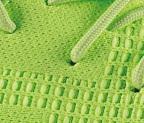
1976
FrankRudyof NASAdesigned thefirst air-cushioned athleticshoe, involvingbags filledwith pressurisedgas thatcompress underimpact,in collaboration withNike.

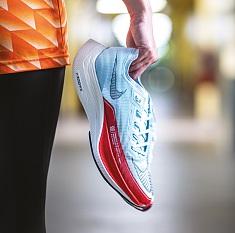
1987
NikeAirMax was releasedas theworld’s firstsneaker withavisibleair cushionasa shockabsorber.
1986
ASICSlaunched theirfirsttrainer withGEL cushioning, involving compoundmade ofsilicone whichwas foundtodisplace 28%more impactthan traditionalair technology.
2013
NewBalance presentedthe firstrunning shoes manufactured using3D technologies.


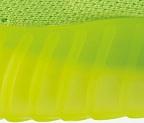


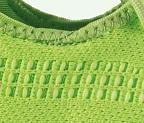

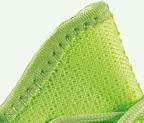
2005
Vibramreleased theFiveFingers shoefor kayaking,which becamepopular amongrunners, asitallowedthe foottomove naturally.

Research developments inrunning shoessince2013. What do youthinkthe future of running shoeslookslike? New materials? New designs? New technologies?

Longdistancerunningtimesareimproving. Kenyan athlete Eliud Kipchoge madehistoryon12 October2019 whenhebecame the first person ever to runa full marathonin under twohours. Sam needs to beable to measure progress, performance and results.

Let’s take a more detailedlook at Sam’s workonaday to day basis.
• Conducting product testing: To ensure that thesports footwearis meeting thedesiredlevel of performance, Sammay conduct various product tests to measure the efficiency of power transfer, grip, traction(griporadhesionbetween twosurfaces),supportandenergy return.
• Analysing data: Sam collects datausing various methodssuch assurveys, experiments and observations. Once thedata hasbeen collected, Samuses varioussoftwareand tools to analyse the results. This couldinvolve comparing the performance of different shoes,identifyingareas for improvement and evaluating whether theshoes meet the requiredstandards.
• Working with design anddevelopment teams: Basedon the results of thedata analysis, Sammay work withthedesignanddevelopment teams to suggestimprovements to theshoes. Sammay provide feedbackon thedesign, materialsand manufacturing methods to optimise their performance.
• Communicating withcustomers: Sammay also communicate withcustomers,such as athletesand coaches, to understand theirneedsand preferencesinsports footwear. This feedback can thenbe used to inform future product development.
Metrology playsa crucial roleinensuring thequality and performance of sports footwearin Sam’sjob. By using preciseandaccurate measurement techniques, Samusesdifferent instruments to measure the efficiency, gripand consistency of the footwearso that data drivendecisions canbe made to improve itsdesign and performance.
Directreadinginstruments

Haveascaleandthesizeofthecomponentis matcheddirectlywiththatscale. Forexample,youcanreadameasurementdirectly offarulerifyouputitbesideastraightedge.
Indirectreadinginstruments

Measureaquantity
indirectlybymeasuringotherrelatedquantities
Forexample,athermometermeasures temperatureindirectlybydetectingtheexpansion orcontractionofaliquidorgas thatisrelatedtotemperature.
Direct measurement is performed using thescale of the measuring instrument,e.g.ruler.
Indirect measurement isdone by comparison with a referencedevice, e.g.agauge block.
ScantheQR code to watchthevideo‘Top5BEST Running Shoes of [2023]’ andanswerthequestionsbelow.
1. What isthebestlongdistancerunningshoe availableonthemarket? Give three reasonswhy.
2. Whichisthebest comfortableshoe? Give two reasonswhy.
3. Whichisthebestall roundrunner? Give three reasonswhy.
4. Namethebeststability shoeandpointouttwo reasonswhy.
5. Namethebest overallrunningshoeandsuggestthree reasonswhy.

Mass
Theamount of matter inanobject. Thestandard unit of massin the SI systemis thekilogram(kg).
Example: The mass of arugby ballis0.41–0.46kg.

Speed
Speedis theamount of distance coveredina period of time. It is measuredin metres per second (m/s).
Formula:
Average Speed= Distance Travelled/Time Taken
Example: An athlete runs500 metresin100seconds. Calculateher averagespeed over the500 metres.

Average Speed= Distance Travelled/Time Taken =500 metres/100seconds =5 m/s
Velocity
Velocity isspeedinagivendirection.
Formula:
Average Velocity = Distance Travelledina Given Direction/Time Taken
Example: An athlete runs500 metresnorthin100seconds.Calculateher average velocity over the500 metres.
Average Velocity = Distance Travelledina Given Direction/Time Taken =500 metresnorth/100seconds =5 m/snorth
Acceleration
Accelerationisa changein velocity. It is measuredin metres per secondsquared (m/s2).
Formula:
Acceleration=Changein Velocity/Time Taken =(Final Velocity – Initial Velocity)/ Time Taken
Example:
A Formula1driver presseson the car acceleratorandincreases theirspeed from100km/hon the homestraight to 120km/hin20seconds.Calculate theiracceleration.

Acceleration=Changein Velocity/Time Taken =(Final Velocity – Initial Velocity)/Time Taken =(120–100)/20 =1 m/s2

1. Find the averagespeedin metres per second of a car that travels:
(a)3500 m in10 minutes
(b)500 m in2 minutes
2. A car travels157km with an averagespeed of 28 m/s. How longdoes thejourney take?
3. A person walksalonga road at a constant speed of 1.5 m/s. How far will they walkin:
(a)15seconds
(b)15 minutes
(c) An hour?
1. Setuptheapparatus asshown in thediagram.
2. Measure thelength of the card, l,and the distancebetween thelight gates, s
3. Setthe weights(F) at 1 N.
4. Position the card at oneend of the track,start theblower and release the card from rest.
5. Record thetimes t1 and t2
6. Calculate theinitial velocity, u:u = l
7. Calculate the final velocity, v: v =
8. Findand record theacceleration:
9. Remove one0.1 N disc from theslotted weight, attachit to the card and repeat.
10. Repeat steps4–9 for values of F from0.1 N to 0.8 N and record the results.
11. Plot agraph of F (force measuredin N) against a (acceleration, measuredin m/s2).
A straight line through theoriginshows that, for a constantmass, theaccelerationis proportional to theapplied force.
The weights are transferredbetween thestringand the card to keep the total mass constant. They must bestuck onto the card so that they will move with it.
Theair track reduces friction,improvingaccuracy. Frictionisa force that opposes the motionor attempted motion of anobject.
Mandatory Experiment – Leaving Certificate Physics Verification that Acceleration Is Proportional to Force(a∝ F)
You
Whileitis truethat engineeringinvolvessome maths, thelevel of maths required can vary significantly.
Engineeringisabroad field that has many differentcareersandeachoneneedsadifferent level of mathematical proficiency. For example,industrialengineers may uselessadvanced mathsskills thanaerospaceengineers. Also,engineeringisnot justaboutmaths. It alsoinvolves critical thinking, problem-solving, creativity and communicationskills. Theseskillsarejustasimportant for successin engineeringas mathematicalability.
Thomas Edison,a world famous Americaninventor,did poorly at mathsinschoolbut went on to patent over1,000inventions,includingearly versions of thelightbulb.


Therearetimes where measurements may be takeninaccurately. For example:
• Results couldbe misreaddue to parallax error. Parallaxerroris theapparent shiftinanobject’s positionasitisviewed fromdifferent angles. For example, when measuring the thickness of a sportsshoesole,if the measurement is taken fromanangle that isnotperpendicular to thesole, the measurement willbeinaccuratedue to parallaxerror.
• The measuringinstrument may beincorrectly set, e.g.a weighingscalesisn’tcalibrated (reset to zero)before measuring the mass of anobject.
• The measuringinstrument may not be functioning properly,e.g.astopwatchisslow.
Adidasmadeagroundbreakingmove in2019withthelaunch of theirfirstfully recyclable runningshoe,the Futurecraft Loop. Unliketraditionalsports footwear,whichare composed of differentmaterialsglued together,the Futurecraft Loopshoeismadeentirelyfrom asinglematerial–thermoplasticpolyurethane. This completelychangedproduction techniques,asthedifferent pieces were fused together withheat instead of glue. Once the shoeshave servedtheirpurpose,they are returned to Adidas. Next,they undergo athorough cleaningprocessbefore beinggroundinto pelletsandmeltedinto material for new shoes. Thisprocessensures zero wasteandnothingisthrown away.

 Images courtesy ofAdidas
Images courtesy ofAdidas
Findfive ways thatengineersare working to makematerialsusedinsportingproducts more sustainable.
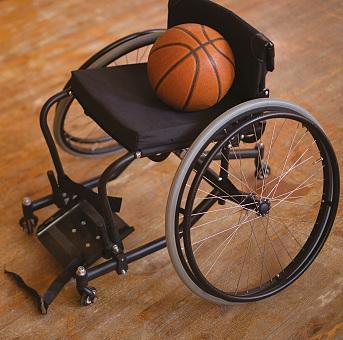

A basketball player whoisalsoa wheelchair user may need to move at significant speed, make sharp turnsand usealot of upper bodystrength. The wheelchairneeds to be modified to handle this.

Specifically, the rotaryhandrail,seat cover and frameneed to provide the basketball player with enoughstability, comfortandsafety to allow them to concentrateon the mostimportant thing– thegame!
An engineer’s understanding of differentmaterialsand theirspecific characteristics willhelp them tomake informeddecisions. For example:
1. The rotaryhandrail couldbe made of aluminium or tabularsteelbecause they areboth light andstrong.
2. Theseat cover couldbe made of leatheror nylon because they aredurableand resistant to wear.
3. The frame couldbe made of aluminium,tabular steelor carbon fibre because they arelight and strong.
This thinking canalsobe mappedonto othersports whereequipment may need to beamended for sportspeople with additionalneeds.
Seat cover
Name: Olivia Donohoe and Sarah Blade
School: Scoil Pól,Kilfinane, Co. Limerick
Project: Investigation into electrolyte levels of different sports drinks for the rehydration of athletes

Aboutthe project: We tested the conductance of several brands of energy drinks to investigate which brand contains the most electrolytes Electrolytes areessential forrehydration and endurance during physical exercise We created a conductance measuring circuit using a multimeter, a battery, straws and copper wire We measured and recorded the current and voltage in each energy drink anddocumented our findingsto calculate the conductance.
Ourresultsshowed that orange juice contains the highest concentration of electrolytes, since it hasthe highest conductance and is therefore the most effective in rehydrating thebody after exercise. Monster contains the lowest concentration of electrolytes, as ithasthe lowest conductance.
Rotaryhandrail Olivia Sheehan, Engineer Manager
Olivia Sheehan, Engineer Manager
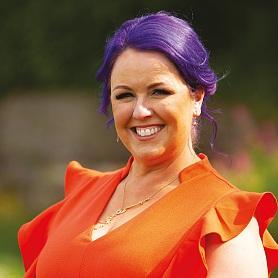
What was your education journey to where you are today?
In school,Istudied chemistry, physicsand geography. Idida BSc in chemistryin college. After that,I worked at a pharmaceutical company for 14 years,inquality control. In 2016,I took up a rotationin theglobal planning team. To support this,I completeda two year master’sinsupply chain management. Then,in 2020,I moved to the materialandsurface technologygroup. I managed thelaboratory and the cleaningand metallurgy teams.
What would you say to your 16-year-old self?
My 16-year-oldself wouldbesurprised that Iaminengineering. Backthen,Ihad my sights on pharmaceuticals. The constantchangeinengineering excites me.Ilove change. If we arenotchanging, we arestationary,and that, for me,isboring.
I was going to stay inquality controland move upthe ranks. In 2013,Ididn’t get ajob that Iapplied for. I was very upset about it for about a year. On reflection, this was the greatest thing that everhappened to me. If ithadnot occurred,I wouldn’t have gone to planningglobalsupply chainorjoineda medtech company My adviceis:don’tplan too far into the future.Aslongas you arehappy,interested,learningandhealthy, thenjust go with it.
Also,don’t be afraid to push yourselfas far out of your comfort zoneas possible. You need to be comfortable with knowing verylittle at times. Learningis part of the process inengineering.As youpush yourself, you get to discover new abilities. You also find that you areable to do more than you ever thoughtpossible.
I manage the people who manage the programs. It’s interesting, challengingand exhaustingbut so worthwhile. Our peopleand the work they doinspire me everyday. New Product Introduction(NPI)isanadventure,andIlove its thrillandbuzz. Thereisa strong team mentality, and people’s passion for theirjob excites me.
A common misconceptionis that engineersareso technical that they can’t be good peopleleaders. Everyone canlearn to bea good coachand mentor. Obviously,someare more natural than others. But itisin every person to refine their powerfulpeopleskills. Anyone who wants to beanengineershouldjustdoit! It’s a fantastic craft to beable to learnand refine your skillsin.
Thesoft skillsI usein thisjobarebeingempathetic andkind. My great skillisbeingable to connect onadeeplyhumanlevel with all the peopleI meet and work with Kindness doesnot go unrewarded. People want to belistened to,heardandseen.
1 Explain the role of asportsengineer.
2 Define metrologyand mass.

3 Distinguishbetweendirect andindirectmeasurement.

4 Explain thedifferencebetweenspeedand velocity.
5 Calculate the averagespeed of an athlete whoruns10kmin30 minutes.
6 Calculate theacceleration of a car that moves from30km/h to 120km/h in3 minutes.
7 Suggest three reasons why measurement readings canbeinaccurate.
8 List three ways arunningshoe canbeengineered to be more efficient.
In 2018,runners wearing thenew Nike® Vaporfly 4%TM runningshoebroke world records. Theinnovativedesign featuresand materials usedin theshoe helped to reduce energyloss.

Writeadesignbrief for asportsshoe manufacturer withtwosuggestions for improvement. Theshoe canbe for any sport. Explain why changeisneeded and what theimpact of theimprovement islikely to be. Below aresomequestions to get you started:
1 How could theshoelookbetter?
2 What would you want the materials to dodifferently?
3 Could theshoe manufacturing processbe more sustainable? How?
4 How could you improve the comfort of theshoe?
5 What technology could theshoebelinked with to feeddata back to the user (e.g.asmartwatch)?

Thenexttime you’re at asports pitch,seea cyclelaneina city orvisitagym,take note of which materialsare used, the clothes worn by the athletesand thedesign of the environment. How do they help thesportspeople?
1 Research informationonnew developmentsinrunningshoes.

2 A series of insights for the‘Top5 BEST Running Shoes of [2023]’.
3 A set of calculations regardingspeed, velocity andacceleration.
4 A Leaving Cert experiment verifying that accelerationis proportional to force.
5 A list of ways engineersare working to make sports materials more sustainable.


Engineering,pairedwith everchanging technology, affectsthe way we canlearn. In thetwenty-first century,the way knowledgeissharedandstoredis vastlydifferentfrompre-technologydays Today we learnwithaclick of ourfingersthroughsearchingonline,avideotutorialorchattingwith abot. Engineersdevelopnew softwareandautomationthatmakelearningpossible.

In addition to the variousdigitalplatformsand tools available for learning,podcastshave emerged asapopular way to gainknowledge. Furthermore,themetaverse,avirtual worldwhereindividuals caninteractwitheach otheranddigitalobjects,islikely to transformthe way we learninthefuture. Artificialintelligence(AI)helpswithmodernlearning by suggesting content,adjustingdifficulty levelsandgiving feedbackin realtime to improve learning results. The continueddevelopment of engineeringand technology, includingpodcasts,themetaverseandAI,isalreadymakingabigimpact andwillshapethe way we learninthefuture.
Jennaisasecondaryschoolstudentwhodiscoveredher interestinengineeringduring Transition Year. She realised thatengineeringismorethanjust constructionandbridges andthereare varioustypes of engineering,including civil,mechanical,chemical,aeronautical,biomedicaland manufacturing. Jennafindsengineering excitingbecause itisagrowingand constantly evolvingcareer. Shechooses to studyphysics,chemistryandengineeringasheroptional subjects for Leaving Cert. Jennastruggles to findtime to study andthinksit wouldbea goodideaifshe could record apodcast of herstudynotessothatshe couldlisten to themonthebus to school, whenbrushingher teethor at othertimes. Let’shelp Jennaoutwiththisidea.

First,like any engineer, Jennaneeds to findtherightprocess to guideher work towardsa result. Shesearchesthe Teach Engineering YouTubechannelandfindsavideoon‘Design Thinking’. Design Thinkingisaseries of stepsthatengineers follow to comeupwithsolutions to problem.

The key questionthat Jennaisaskingis,‘How doIcreate apodcast of my studynotes?’Shethinksit shouldbeasimpletaskbutshesoon realisesthattherearesome constraints:
• Her budget for theprojectis zero
• She wants to useher mother’slaptop to create thepodcast,butsheneedsthefile to be transferable to herphone for easy listening.
Jennathinksabouttheinformationsheneedsandputs togetheralist of questions to research.
CanIaccessaquietplace toensurethereisno backgroundnoise?
Jenna goes to Quora.com (a questionand answer website) to findoutwhat other peopledowhenthey want to record a podcast. Shediscovers thatthere aremany different tools youcanuse,suchas Audacity, Podcastle, Apple Podcasts, Skypeand GarageBand.
Jennausesalltheinsights,ideasandinformationgatheredduringtheprevioussteps to generate creativeideas to answerthequestion,‘How doIcreate apodcast of my studynotes?’
She comesupwithalist of toolsandthinksaboutwhatthe results wouldbeifsheusedthem. However, some tools:
• Costmoney (sothey’re out)
• Involvesoftwarethattakeshoursandhours to learn (sothey’re out)
• Requirespecialhardware (sothey’re out). She keeps researchinganddiscovers theaudio editorand recordingsoftware Audacity®. Thisis:

• Free
• Opensource
• Easy to use

• Cross-platform(itallows files to bemoved betweendevices).
It lookslikeithaslots of functionality.
Jennanow hasacleareridea of whatsheneeds to do to start recordingherpodcastand comesup withasixpoint plan:
1. Download Audacity to herlaptop
2. Learnhow to usethe technology by watching YouTubevideos
3. Choosesomestudy notesfromonechapter inphysics;ensurethey areaccurate andprepare to readthemoutsothatthey canbe recordedonapodcast
4. Testthelaptopmicrophone
5. Findaquietplace to record
6. Record onechapter andseewhathappens afterthat.
Jenna gets everything ready,pressesthe red‘Record’buttonandstartstalking!
Jennaneeds totesttheideashecameupwithinthis Design Thinkingprocess. Thisstephelps to identifyany issuesandgivesheranopportunity to refineit.

Shenotesdownher expectationsbeforerecording,i.e.she expectsshewillbeable to readitout perfectlyinaboutfiveminutes. Afterwards,shelistensbackand realisesthatshestumblesa couple of timesandlaughsonceinthemiddle,whenshelosesher way. It takesher 12minutes to read everythingaloud.
Shehasachoicenow. Doesshe re-recordthewholethingorlearnhow to editoutthosepartsshe doesn’t want inthere?
Record someaudioon Audacity withintentionalmistakes. Next,searchonline for tutorials abouthow to:
• Delete aselection of audio (where you recordedthoseintentionalmistakes)
• Remove white noise
• Addapplause at thebeginning of thepodcast

• Findsomefreemusic youcanuseandaddittothepodcast.
Jennadecides to startagainand record thewholething. Therearetwothingsshe wants to do to makeitbetter:
• Guaranteethatshecan record thewholethingwithout any mistakes
• Remove allthenoiseinthebackground.
Jennaasksherengineering teacher for suggestions. He recommends Podcastle,a web-basedAIplatformthatallows users like Jenna to record,editandtransfertheir content. Using Podcastle, Jennacan copy hernotesinto theeditor and generateapodcastthatusesanAI voice. Thiswillallow her to record hernotes fasterandtake advantage of theediting tools.
Jennahassucceeded! Shehasnotonly recordedhernotesonto apodcastthatshecanuse for study, shehasalsolearnedtheskills of podcastingandhow to apply Design Thinking!Asshe goesthrough thisprocess, Jenna realisesthatherpassion for engineeringisdriven by herpassion for solving problems.
Writeaparagraphtitled ‘A Day intheLife of an Engineer’. Then record itasapodcastusing one of Podcastle’s stockAI voices.

As Jennalooked at thepicture of her recordingin Audacity, shesaw lots of waves. Soundisproducedwhenanobjectvibrates. Allsoundsarecreated by movingobjects. Therefore,soundisassociatedwithkinetic energy(go to page26 to recaponkinetic energy). For example,if youclap yourhands orcloseadoorloudly, youwillhearthe impact.

Soundtravelsthroughtheair (or any other medium) asa wave These wavesarecaused by vibratingobjects,suchasguitarstrings oraperson’s vocal cords.Asthey causethe eardrum to vibrate,thebraininterpretsitassound.

Pitch isaproperty of soundwherenotesareperceivedashighorlow in relation to each other. It isdetermined by thefrequency of thesound wave For example,awhistleproducesahigh pitchedsound,whileabassguitarproducesalow pitchedsound.

Soundtravelsthroughamediumsuchasairor water at aspecificspeed. The speed of sound can varydependingontheproperties of themedium,suchas temperature. For example,onahotday thespeed of soundis fasterthanona coldday. An echo isa reflectionorpartial reflection of sound. Hard surfacessuchas walls,cavesand mountains reflectsound.Softsurfacessuchascushions,carpet and foamabsorbsound.
As wavesmeet,they combinewitheach other to create an interferencepattern. An example of interferenceisthehissingsound youhearif youtry to manuallytunein to a radiostation.
Jenna’s successwithherpodcastledher to explore otherareaswhere technology canhelpeducation. The metaverseisthe3D version of theinternet. Ratherthan seeingimages, textandvideo, your ‘avatar’ willbeable to walkarounda3Denvironmentwhere youcanvisit places,timesand otherenvironmentsvirtually.
Imaginebeingable to practisealanguagewitha robot whocanhearwhat youhave to say, responds to you

in realtimeandgives you feedback. Imaginestandingonaglacierin Antarctica to seethe effects of global warming. Imaginestandinginthestreets of Ancient Rome to seewhatit waslike2,000 years ago. Imaginestandingonthepitchduringa World Cup to calculate thespeed of theballscoringa goal. Imaginebeingintheaudience at Paris Fashion Week,notingthe fabricsusedintheclothes. That’s whatthemetaverseisallabout!
83.5% of metaversevirtual worldusersareunder18 at thetime of writing. Thefirst everAR (augmented reality)andVR (virtual reality) concert experience wasa collaborationbetween rapper Travis Scott andthegamingplatform Fortnite in April2020.
ScantheQR code to create yourmetaverse avatar.

Go to YouTubeandsearch for thevideo‘Educationinthe Metaverse’. Suggestthree ways that teenagers couldusethemetaverse to learn differentlyinthefuture.
TimeRideisabusinessin Germany that offerspeopleanimmersive experience,journeyingbackintime tounderstandwhat Frankfurt used to looklikeorwhatlife waslikewhen Berlin wasdivided. Scanthe QR code to checkitout!
Therearemany routes to acareerinengineering. Engineers comefroma variety of backgroundsandholddifferentkinds ofofficialqualifications,suchas:
• A multi-year collegedegreeinascience,mathematicsorengineeringfield
• A certificationfromanengineeringorganisationsuchasABET, or Accreditation Board for Engineeringand Technology

• Apprenticeshipprogrammes
• An engineeringlicence
• Non-traditionalcredentials,suchasprofessional certificates,project portfoliosand codingbootcamps.

As youcansee,there isnoonesizefitsallapproach to becominganengineer. Whilea collegedegreemay bethetraditional route,itisnottheonlyoption available.Aspiringengineersshould explore all of theiroptionsandchoosethe paththatbestsuitsthem. By doingso,they canachieve successinthefield of engineering regardless of theireducationalbackground. Findout more aboutapprenticeships at www.apprenticeship.ieor by scanningtheQR code.
Engageina walkingdebate onthe following topics:
1. The MetaverseasaVirtual Paradise
Thisviewpointsuggeststhatthemetaversecanbeanideal worldwherepeoplecan enjoy limitlesspossibilities,freefromthelimitations of thephysical world.
2. The MetaverseasaVirtual Trap
Thisviewpointsuggeststhatthemetaversecanbeavirtual worldthattrapsindividuals into adisconnected reality,wherethey may becomeaddicted to thedigital realmand lose touchwiththe real world.
3. The Metaverseasa Tool for Learning
Thisviewpointsuggeststhatthemetaversecanbeapowerful tool for learningand education,providingimmersiveandinteractivelearning experiencesthatcanimprove traditionalclassroomlearning.
4. The Metaverseasa Threat to Privacy
Thisviewpointsuggeststhatthemetaversecanposeathreat to personalprivacyand security,asit collectslarge amounts of dataonuserbehaviourandpreferences. Your teacherchooseswhich corner of the room representswhichviewpoint. Aftera few minutes to thinkaboutthe topic,eachstudentshouldmove to the corner of the roomthat linkswiththeirchoice. Your teacherwillask for volunteersfromeach corner to explain their reasoning. Studentsarefree to changetheirmindwhilelistening to thedebate and move to another corner of the room.

Now that you have learnedaboutthe metaverse,let’s thinkabout how it can create personalised experiences for users. It allstarts withmachinelearningalgorithms.
An algorithmisa processorset of rules to be followedin calculationsor other problem-solvingoperations,especially by a computer.
For example,in the tablebelow, thealgorithm used to generate thenumbersin the‘Sum’column is ‘Add the firstnumberand thesecondnumber’. In aspreadsheet, each cellislabelled by its unique row and column reference. The row is represented by anumberand the column is represented by aletter.
For example:
8is foundin two cells,i.e.A2andA5
3is foundinone cell,i.e. B6.
• Human: If you gave a person the taskanddidnot give thema calculator, they would calculate8+6 in theirhead to get 14.
• Humanand calculator: If you gave a person the taskandaccess to a calculator, they would key in ‘8+6’and press‘=’ to get 14.
• Humanand algorithm: If you gave a person the task andaspreadsheet,they could put in ‘=A2+B2’and thenumber14 wouldappear.
Calculatorsare fasterand more accurate thanhumansin providinganswers to sums,but algorithms arebetter at reacting to changesin thedata For example, ifanumberina table changed,ahuman wouldhave to redo the calculation, whileanalgorithm would fix itautomatically.
Thealgorithm for findingthesum of twonumbers wasgiveninthe exampleonpage100. Usingthetablebelow,writesimilar algorithms for subtraction,multiplicationanddivision.
AIisawide rangingbranch of computerscienceconcernedwithbuildingsmartmachinescapable of performingtasksthatuntilnow have requiredhumanintelligence.
To illustratethis,imagine youareseekinga Summerjoband want to prepare for theinterview by finding20 commoninterview questionsandanswers. If yousearchonasearchengine, youwilllikely findalist of questions. However, if youengage withanAIbot (short forrobot),itwillnotonlyprovide youwiththequestionsbutalso continuethe conversationwith you.
Writeafivelinelimerickincludinga reference to podcasting,engineeringasa Leaving Cert subjectand Transition Year.
In Transition Year, we did explore, Engineeringandpodcastsgalore, Fromcircuits to mics, Our passion tookflight, Creatingaudiotales we adore!
Suggestanotheroneand factorinsustainability too.
In Leaving Cert, we learnedwith zest, Of engineeringandsustainability’squest, Withpodcasts, we’d preach, How greenchoices reach, A futurewhere Earthistrulyblessed!
Create afreeaccountwithan OpenAIchatbotandaskitthe following:
1. Suggestthree ways thatI coulduseAI to helpmestudybetter for the Leaving Cert.
2. What arethe fastestgrowingjobsin Irelandwithsalaries over €150,000?

3. Tellmeaboutsomeengineering rolemodelsin New York, Berlin, Singaporeand Sydney.

Machinelearningiswhen computerscanlearnontheir ownfromlots of information,likepicturesor numbers. It islikewhen youstudy andlearnnew things,butinstead of aperson,a computerisdoing itautomatically.
It happenswhenthe computerusesspecial rules to figureoutthingswithoutbeingtold what to doeachtime. Instead,itlooks at alltheinformationithasandtries to find patterns to makepredictions.
For example,if youshow amachinelots of pictures of stopsigns,itcanlearnwhata stopsignlookslike. Then,when youshow ita picture of astreet,itcantry to findastopsign init. Self-drivingcarsusethiskind of learning to helpthemdriveontheir own.
Theimageontherightshows an example of whataself-drivingcarcansee. Remember what youlearnedaboutself-drivingcarsinChapter 2.

ScantheQR code to watchavideoonmachinelearning. Create an infographic of the key ideas explainedinthevideo.
Deeplearningdescribesalgorithmsthatanalysedatawithasimilarlogic to how ahuman woulddraw conclusions. Artificialintelligence(AI) isabranch of computer science focused onbuildingsmartmachinescapable of doingtasksthatuntilnow have requiredhumanintelligence.
Artificialintelligence
Machinelearning
Machinelearning usesalgorithmstolearnfromdataandmake decisionsbasedonwhatithaslearned.
Deeplearning
Deeplearning isanadvancedtechnologythatimitateshow the humanbrain works.Itdoesthisby constructingacomplex network of algorithmscalledanartificialneuralnetwork. Thisnetworkisdesignedtoprocessandanalysedatajustlike our brainsdo. By usingmultiplelayersof algorithms,theartificial neuralnetworkcanlearnfromthedatait receivesandmake intelligentdecisions withouttheneed for humaninput.
Narrow artificial intelligence (weakAI)isaspecifictype of AIin whichalearningalgorithmis designed to performasingle task,andany knowledgegained from performing that task willnot automaticallybeapplied to other tasks.
For example,if you ask Amazon’s Alexa to play asongor tell youthetime,it willdo that only, without trying to also figureout how thesong youplay might affectwhat youmight like for dinner.
Artificial general intelligence (strongAI)aims to create intelligentmachines that are indistinguishable from thehuman mind(i.e. you couldnot tell whether you were interacting with a personora robot). For example,imagineifa robot was to writea play justlike Shakespeareorany otherauthor you have studiedin English.



Siskaresettingastandard of excellence through their use of machine learningon constructionsites.As part of the company’s digitalapproach to construction projectmanagement, construction camerashave become anintegral part of Sisk’sdailyoperationson many projects. Thisensures better work practices by providing Sisk withthedata needed to increase productivity onsite. One feature of theirdigital management isa Gate Report. This tool, provided by Evercam, combines AIand machinelearning with visuals to create alog of all vehiclesenteringand exiting thesite, a breakdown of the type of vehicleandalog of thetimeeach category of vehicle wasonsite. The Gate Reporthelps to reducecosts,delays anddisputesonsite. By analysing thedata, trendsandbottlenecks canbeidentified. Reducing the waitingtimes of vehiclesdropping off construction material can alsosave money on transport costsandtime. A better flow of vehicles canbesetup andschedules kept on track. Thinkback to what you learnedabout lean manufacturinginChapter 2.

Search for the terms ‘Janssen’, ‘AI’and‘Machine Learning’orscanthe QR codeandseehow thepharmaceuticalarm of Johnson& Johnson isfinding ways to beinnovativewithAIandmachinelearning.

Watchthevideocalled‘How AI Makes Buildings More Sustainable’ on YouTube. Answerthe followingquestions:
1. What doesBMSstand for?
2. What percentageisthesensormarket expected to grow by inthenext five years?
3. What twothings couldAIadjustonafloor, basedonwhoisinthebuilding?
4. If abuildingcanpredicthow hotitcanbeonaparticularday, how canthatinformationbe used?
Siskhave been using theenvironmentalsocialand governance(ESG)platform SmartWaste since2011 to manage theirsustainability andenvironmental challenges. Initially, the platform was used to capture wastedata,but itisnow used to capturedata for water, energy,timberandidentifyingsuppliers who usesustainable products.
Maintaining momentum onsustainability is veryimportant to Sisk. Monthlydata reports from SmartWasteshow progressagainst Sisk’sCarbon Reduction Planand Sustainability Roadmap targets.
Siskarenow using SmartWasteacrossall their construction projects. Thishasincluded the complex Project Kells retailand office development in Dublin city centre, thedesign and construction of the M17/M18 Motorway Schemeand theCapital Dockmixed use development in the Dublin Docklands.


Investigatehow Sisk is making asustainabledifference and present asummary of the research to yourclass using PowerPoint.
Names: Ciara Fallon, Martha McSharry, Amy McGovern

School: Our Lady’s Bower, Athlone, Co. Westmeath
Project Name: I’ll Play It My Way – a learning algorithm to individualise sensory play room stimulation
Aboutthe project: We created a smartwatch withthe BBC micro:bit controller that can detect a person’s sensory interaction in a sensoryroom Using a Raspberry Pi device, we implemented machine learning to control the sensory displays in the room This allowed us to learn and customisethe sensoryroom’s behaviour specifically for each person, providing them withthe appropriate level of sensory input.
Wehadagreattimeworkingonthisprojecttogether Wegainedknowledgeaboutfuzzylogicandhowmachinelearning algorithmsfunction.Wediscoveredthatthesealgorithmscanlearnfromdatarepeatedlyanduncoverhiddeninsightswithout explicitinstructions.Machinelearningenablescomputerstoadaptandevolvewhenexposedtonewinformation.Themachine learningaspectwasfascinating,andwegainedvaluableinsightsintothetechnologyusedincreatingsensoryrooms.
 Donal Óg Cusack, Engineering Manager
Donal Óg Cusack, Engineering Manager

What was your education journey to where you are today?
Isat my Leaving Cert at MidletonCBS. Ididn’t have any interestin going to collegeand wanted to work with my hands.Iserved my time asanelectrician, which wasagreat educationinitself,beforereturning to formaleducationinlater years.Iam currently completinga master’sin Digital and Automation Engineering through UCC. Last WinterI completedadiplomain Operational Technology Cyber Security through the University of Limerick.
What would you say to your 16-year-old self?
Embrace thejourney of self-discovery, for itholds the key to your growth and happiness.Cherish the presentmomentsanddon’tfret over the uncertainties of the future. Believe in yourself– you are capable of achievingbeyond your imagination.
What have difficulties or failures taught you in your career?
Difficulties taught memore about myselfandgave me resilienceand thestrength to overcome challenges.
What does a typical work day involve for you?
Ilead the Digitaland Automation Systems Team for a medicaldevices company. We mainlyoperatein thearea of convergence of IT(information technology)and OT (operational technology).ITis focusedondata and communication, whereas OT is focusedonbehaviours andoutcomes.Ispendtimeinteracting with other teams and project coordinators,solving problems, trackingour project and coming up with ideas. Our teamlooks for ways to automate repetitive tasksandimprove how we manufacture medicaldevices. We designand create automationequipment to streamline manufacturing. When the machinesarein use, we run testsonequipment, study the resultsand make adjustments wherenecessary.
Where did your passion for engineering come from?
I wouldsay itstems fromastrong work ethicinherited from my parents,along with a willingness to follow my grandfather’sadvice of ‘live while youcananddie when you can’t helpit’.
1 Stateand explaineachstep of the Design Thinking model.
2 List three characteristics of sound.
3 Explain why soundisassociated with kineticenergy.

4 Illustrate how anecho works.
5 What evidencesupports theidea that soundisa form of wave motion?
6 Explain what the metaverseisin your own words.

7
Define:
(a) Algorithm
(b) Artificialintelligence
(
c) Machinelearning
8 Write thealgorithm that wouldlead the first two columns of data to generate theoutput in the thirdone.
9 Distinguishbetweenhow ahuman usinga calculatorandanalgorithm wouldhandle Question8if the figuresin ColumnB were constantly regenerated.
10
Highlight examples of weakAIinasearch engine.
Choose(A)or(B)below.
A Define the term ‘artificialintelligence’ andgive examples of machine learninganddeeplearning.
B AIand ethics: writea paragraphon the ethical concerns of usingAIin thebusinessand manufacturingindustry.



Thinkaboutthe ways you study today in comparison to yourparents. Consider the fact that you have ebooks, explainerson websites, YouTubevideos,anonlinestore of Leaving Cert papers, etc. How many examples of new learning resources can youfind?
1 A podcast recordedand producedon Audacity.
2 A podcastscript generatedon Podcastleabout ‘A Day in the Life of an Engineer’.
3 A metaverse avatar.
4 A list of ideas of how teenagers couldlearn through the metaverse.
5 A range of algorithms for basic maths functions.
6 A chat with ChatGPT.
7 An infographicaboutmachinelearning.
8 An understanding of how Janssenis usingAIand machinelearningin pharmaceuticals.
9 Insights onsustainablebuildings.
10 A class presentationabout Sisk’ssustainability efforts.



Automationengineeringisafield of engineeringthatinvolvesthedesign,developmentand deployment of systemsthatcanautomatically performtasks. Thisisparticularlyhelpfulwith repetitive orboringtasksthat would otherwiseneedahuman. Technology canspeedupmany tasks to givepeopletime to do otherthings. Automationengineeringalsomeansthatmachinescanpredict whenthey willbreakdownorneedmending,savingthefrustration of malfunctioningunexpectedly. Automation systemsaredesigned to be efficient, reliableand cost effective. They canbeusedina wide range of industries,frommanufacturingtohealthcare to transportation.
Thinkback to what youlearnedaboutthetestingstepinvolvedin Design ThinkinginChapter 6. Examples of modernautomationengineeringinclude:



Self-drivingcars

Grainne worksasanautomationengineer. She workswith otherengineersandpeoplewhoneedautomated systems to figureoutwhatthey need. Then,sheuses computer programsand tools to makethose systems. She teststhe systemsandfixesany problems. Shealsolooks at data to makesurethe systemsare working well. Grainneis good atworkingwith othersandlikes to solveproblems.
Industrial robotsusedinmanufacturing Automated systemsusedinhospitalsand healthcare facilities.Overall, Grainne’s job focusesonautomating the manual, workintensive tasks of thedesign engineers. Sheappliesher codingskills to specificfunctions,such assetting upmonitoring systems, creatingalertson productionlinesso that management know ifanything goes wronganddesigning dashboards to measure performance. Grainneisdriven to make things more efficient, fasterand easier for others.
In today’s technological world, thereisanincreaseddesire to automate processes. Grainne’s skillsare indemand with otherengineersand withproduction,salesand projectmanagementprofessionals.


Automationisbasedonan‘if, then’ loop. For example, thinkabout the way analarm clock workson yourphone. Theinstruction wouldbe:





If it’s 8am, then play thealarmsound. If it’s not 8am, then don’tplay thealarmsound.
What meisit?
Q: What makesthingsautomatic?
A sensor responds to change. For example,lightsensorsdetectchangesinlightlevelsandare commonlyusedinautomaticlighting systems. A lightsensorcanbeused to turnonthelightswhenit getsdarkoutside. Sensorscanalso respond totemperature,pressure,speed, etc. Varioustypes of sensorsareused aspart of electroniccircuitsinengineering systems.

A triggerisaspecific (number of)action(s) performedonselected conditionswhenan eventis launchedviaasensor.
A specific example wouldbe:whenthe waterinthe kettle reachesa certain temperature,thebutton istriggeredsothatthe kettleelementstopsaddingheat. Ingeneral,a robotisamachinethatgathersinformationaboutitsenvironment (senses)andusesthat information (processes) to follow instructions to do work (acts).
An automaticdoordetectsmovementusingsensors. Thesensorsprocessthis to sendasignal to a computer systemthat tellsit to actandopenthedoor.
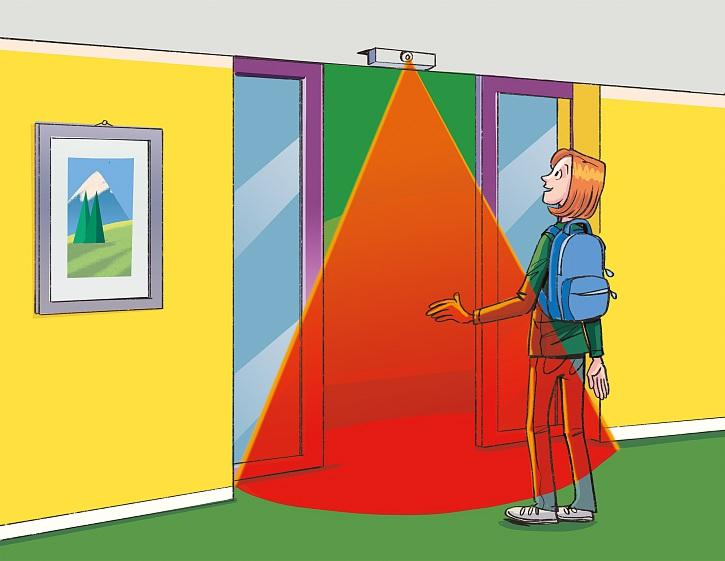
Q: What happensif we don’thave automation?
Withoutautomatedprocesses,thesameactionsneed to bedonemanually. So, for example,withoutan alarmclock, you wouldhave to keep wakingup to checkthetime,hopethat you would wake up at the righttimeorasksomeoneelse to wake you.
Senses Processes ActsAn engineerlike Grainneisalwayslooking for ways to automate. Sheis constantly striving to make things more efficient, fasterandeasier for others. She usesdifferent toolsand models to helpher,including Description–Analysis– Evaluation.

Askquestions to helpestablish thebackgroundand context, such as:
• What is this problemabout?
• Whodoesitinvolveor affect?
• Whenand whereis thishappening?
• What opportunities can arise from this?
These types of questionslead to descriptiveanswers,i.e.asummaryor explanation of a topic, event orsituation.
Askingand gettinganswers to analysisquestionshelps to breaka probleminto parts. Consider the relationshipbetweeneach part,and the relationshipbetweeneach partand the whole,such as:
• What are the contributing factors to the problem?
• How might one factorimpact another?
• What ifone factoris removedoraltered?

Thesequestionslead to more analyticalanswers,i.e. they go beyonddescriptionand providean analysisorinterpretation of theinformation provided.
The evaluationstageasks ‘so what?’ and‘what next?’ questions to make judgments and consider the relevance,implications,significanceand value of something. Examples ofevaluationquestionsare:
• What doI thinkaboutthis?
• How is this relevant to my assignment?
• How canIbuildon this learning?
Thesequestionslead to judgments and criticalanswers. They help withmakingadecisionor forming anopinionbasedon theinformationgathered from thedescriptiveandanalyticalstages.
 1.Descrip on
2.Analysis
1.Descrip on
2.Analysis
Let’slook at how Siskhave applied the Description– Analysis– Evaluation model to some of their processes.
Description
Whatis this problemabout?
Thereare repetitivejobs that people need to doin Sisk,such as carrying blocks from the place of delivery to where they’reneeded. This prevents people frombeing creativeanddoing other things. Also, veryheavy materials need to be moved fromonearea to another. This canbedangerous if people move them manuallyorif people use the machinesincorrectly and get injured.
Whodoesitinvolve oraffect?
This problem can affect bricklayers and masonsas wellas their managers. When andwhere is this happening?
On buildingsites everyday. Whatopportunities canarise from this?
• Remove repetitive tasks
• Improve thesafety of thesite
If Sisk can make asuccess of this, what could possiblybenext? How else could automationbe usedacross thesite?

Whatarethe contributing factors to theproblem?
• Blocks can’t bedelivered to the exact place they areneeded for direct construction.
• At the moment, theonly way of getting them to the exactplaceis for a person to load them into a wheelbarrow and move themacross thesite. Thisistiringand repetitive work.
• Liftingblocks, particularly when you doit often, canbedangerous to yourphysicalhealth. How might one factorimpact another? Whatifone factoris removedoraltered?
• If theblocks couldbedelivereddirectly to the place they’reneeded,it would remove theneed for a person to move them fromonearea to another. This couldalso reduce therisk of injury to the construction workers.
• If a machine could move things fromonearea to another, then the place of delivery would matter less,aslongassustainableenergy was used for transportation.
Whatarethe results?
Siskhasbecome the first European contractor to introduce robotics to construction projects, investing€150kas part of its commitment to enhancesite productivity and minimisehealthand safety risks to its workforce.
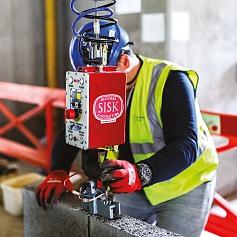

Theinnovative robotic toolknown asa Material Unit Lift Enhancer (MULE) wasdeveloped by the New Yorkbased company Construction Robotics. Thisisaliftassistdevicedesigned for handling material weighing up to 134lb (60.8kg)ona constructionsiteinto place. The tool reducestirednessand injuriesandincreases productivity by between50%and400%.
How is this relevant to the assignment?
The MULEwillnot replacebricklayers or masons; rather,it willimprove their working conditionsand enable them to focus on otheraspects of thejob, such as the pointing of brickwork. How can we buildon thislearning?


The MULE was used to constructthe multi-storey car park at Sisk’s Wembley Park E05sitein London. The car park will form thebase of anew housing development next to Wembley Stadium.
According to SOLAS,the government’s furthereducationand trainingagency, theimpact of automationis expected to resultinan overallincreasein thenumber of peopleemployed over time,butthe type of jobson offerarelikely to changesignificantly. Automation can create new opportunitiesandlead tothe transformation of existing roles. For example, thehealthcareindustry willseeademand for professionals who canintegrateemerging technologieslikeAI, wearablesandhealthsensors.
The field of roboticsis expected to continuegrowing. Opportunitiesarebeing created for engineersand technicians who candesign programs and maintain robots in manufacturing, healthcareandlogistics.
The World Economic Forum hasindicated that 85 millionjobs may bedisplaced by the division of workbetweenhumansand machines by 2025. However, ithasalsoestimated that 97 millionnewroles may ariseinAI,such asAI ethics, human–AIinterfaceand reviewingAIdata.

1. Loginto makecode.microbit.org,create a‘New Project’ andgive yourprojectaname.
2. To make yournameflash uponmicro:bit,clickon‘Basic’ andthen ‘show string’.
3. Move itacross to ‘onstart’ andchangethe textfrom‘Hello!’ to yourname. Pressthebutton withthegreentriangle to play it.
1. Buildthe code youseeinthescreenshotbelow froma SparkFuntutorial. Youwillfinda helpfultutorialon YouTube by scanningtheQR code.
2. Amendthe codesothattherearetwomorepotentialoutputs:‘NotSure’ and‘Maybe’.
Google Sheets isa tool that canhelp you organiseand calculatedata. Youcan useit to save timeand reduce errors by makingitdo thingsautomatically. Thisincludes thingslike maths, processingdata and making charts.
Let’s create your own Google Sheetwithfivedifferent liveshare prices of technologyorengineering companieslistedon thestock market Youcanbuilditso that itautomatically updatesand can tell you if thosestockshave madeagainorlosssince thestart of the year.
1. Opena Google Sheet.
2. Type in the name of a company listedon thestock market. The example uses Meta, Microsoft andCRH.

3. Search online to find their ticker code (stockmarket identification code)andenter it into thesheet.

4. Inputthelive share price of thestock by entering this code: =GOOGLEFINANCE("TickerCode")
5. After the message‘Loading’, thenumbers willappear on thesheet.
6. Formatthe cells containingthepricesintheappropriatecurrency.
7. Determineifthesharepriceis at againoraloss for the yearso far. To dothis,searchonline for theprice at thebeginning of the yearandthen codeinan‘If, then’ loop.
In thesheetbelow, theprice at C4istheLive Share Price (today’sprice) andtheprice at C6 isthesharepriceonthefirstday of the year. Younow need to determinethe expression you want totest. In thiscase,itis:
‘Istheprice today higherthan at thestart of the year?’
Google Sheetsunderstandsthisas: ‘=IF(C4>C6…’
Now, youneed totell Google Sheetswhat you want it to display ifthepriceishigher today than at thebeginning of the year,i.e.‘Gain’. Youalsoneed totell Google Sheetswhat you want it to display ifthepriceislower than at thebeginning of the year,i.e.‘Loss’.
Puttingall of this together,the codelookslikethis:
=IF(C4>C6,"Gain", "Loss")
=IF(C4>C6,"Gain","Loss")

Grainneisavisuallearnerandshe wantsgains to display ingreenandlossesin red. Therefore,she puts anotherautomationin place by clicking‘Format’ and then‘Conditional formatting’ from the dropdownmenu.


Next,she tells Google Sheets to observe tworules:
• If the cellincludes the exact text‘Gain’, then the whole cellneeds to turngreen.
• If the cellincludes the exact text‘Loss’, then the whole cellneeds to turn red.

Explainthe difference betweenhow ‘If, then’ loops are coded into micro:bit and Google Sheets to the personbeside you.
Youmay find this challenging at first,butpersevering withchallengesandbeingopen to learningnew methodologiesisanimportantpart of beingan automationengineer.
Creatingaliveportfolioin Google Sheetsinvolvestrackingandanalysingdata related to stockprices. Dataanalysisisa veryimportantskillinseveraldifferentfields of engineering. Let’s go back to our example of the kettleandseehow automationcanbeapplied to heat.
Heat isa form of energy. It ismeasuredinjoules(J). The temperature of anobjectisameasure of itshotness. The heatcapacity of anobjectistheheatenergyneeded to changeits temperature by 1°C. Heat energy= Heat capacityxChangein temperature
Q=C∆ p
Example:
A cup of waterhasaheatcapacity of 1500joulesperdegree Celsius. How muchheat energy mustbeadded to raiseits temperaturefrom10°C to 25°C?
Q=C∆ θ
Q=(1500)*(25−10)
Q=22,500J
A large cup of waterhasaheatcapacity of 2500joulesperdegree Celsius. How muchheat energymustbeaddedto raiseits temperaturefrom25°C to 50°C?
Each kettle containsametal coil. Electricalenergytravelsthroughthe coil,which convertsit to heat energy. Thisheatistransferred to the waterandtheon/off switchoperatesonan‘if,then’ loop.

Whattemperature



Sustainability refers to planningandbuilding for abetter future. Not onlydobusinesses want sustainable,energy efficient designs, they also want sustainablebusiness models. Project engineers work with stakeholdersand otherengineers to designsustainablesolutions. Sustainablydesigned systemsuselow energy (mainly renewable)sources of energy at a rate that canbe replacednaturally. Youwilllearn more about thisinChapter 8.
Planningsustainably can refer to peopleas wellas theenvironment. Inclusiveengineering meansour communitiesareaccessible to everybody.
Seeking to add to the community, the project construction management team of Janssen, PM Group and Siskjoined forces to volunteer at the Field of Dreams facility outside Ballincollig in Co. Cork, which providesalearningandsocialenvironment for youngadults with Down Syndrome. According to a three year plan, the project will complete footpathsaround the facility and construct anew fruit garden.
Name: Hughie McShane
School: Abbey Vocational School, The Glebe, Donegal, Co. Donegal
Project: App to improve writing in children with dysgraphia
Aboutthe project: I set outto create a game to help the motor skills of people with dysgraphia – an under-researched condition that impairs writing and the ability tostore a pattern in memory. I used the Unity game engine to create a game that is controlled with a stylus and a tablet, in which the player must navigate around patternsto help improve motor skills The patterns were curved and mimicked the shape of the most common letters and so were deliberately designed to develop fluency in letter formation. I also added projectilesto dodge to increasethe players’speed in letter formation and collectablesto encourage playersto complete loops, which are present in many letters The game wasthen tested on several students in the school with dysgraphia They all responded positively tothe game, and mostsaid theybelieved it helped their motor skills.

 Grainne Donegan, Design AutomationEngineer
Grainne Donegan, Design AutomationEngineer

Idid my Leaving Cert, focusingon STEM subjects –honours maths, physics,applied mathsanddesignand communicationgraphics(DCG). ThenI went to UCC to study Civil, Structuraland Environmental Engineering. Ioptednot to doa master’sand went straight into industry. In my firstjob,I got a verybroad work experienceacross thedepartmentsina container cranes company I recentlystarted my dreamjobasasoftwareengineerin Formula1, working for Sauber Group in Switzerland.
What would you say to your 16-year-old self?
I thinkshe wouldbesurprised at how confident I canbein certainsituations.As someone whoisanintrovert,I used to be more inclined to quietly sitbackandonly to speak whenI100%believe somethingneeds to besaid. But now Idefinitely feel confident enoughina meeting to say thingslikeIsee them, regardless of how senior the other peopleare compared to me.
Persistenceis key. You’llhave some toughdays andbe faced with somelarge challenges,but if you’re constantly open to learningandadoptingnew methodology, you’ll eventually click with anew solutionand feelan overwhelmingsense of pride that you achievedsomething at work!
What do you doday to day?
My jobisallaboutusing my computerskills to make the work of designengineers easier.I usea programminglanguage called Python tocreate special programsthat cando certain tasksautomatically. Sometimes,I even make new programs just for our team to use.I work with lots of differentpeople,likeengineersand productionstaff, because everyone wants to use more technologyin their work. That meansIspenda lot of timeemailingand going to meetings.
My favouritesubjects in the Leaving Cert were mathsand DCG. Thesesubjects influenced my decision to pursueanengineeringdegreeasIenjoyed thelogicaland practicalapplications of both.
1 Explain,in your own words, what anautomationengineerdoes.
2 Define the underlined termsin the followingsentence: A thermostat uses automation to maintaina certainlevel of heat, as measured by its temperature.
3 Describe thedifferencebetweensensorsand triggers.
4 Findouttheticker code for the followingengineering companieslisted on thestock market:

Tesla:
SnapInc.:
Sony:
Qualcomm:
General Electric:

5
What code would you suggest to theautomationengineer who would like to usean‘if, then’ loop to identify whether today or yesterday hada higher temperature?
AB
1 Degrees Celsius
2 Temperature today
3 Temperature yesterday
4
5 Whichday ishotter?
6 For Question5, put togetherastep by stepguide explaining to somebody with little experience of formattinghow to add conditional formatting to that sheet.
7 Explain the‘Senses– Processes– Acts’ process for a car park where the machinedecides who canleave and who cannot basedon whether they have paid for their parking.
8 Writeashortstep by stepguide explaininghow to codea micro:bit to generate the word ‘automation’ whenswitchedon.
9 If a cylinder of liquidhasaheatcapacity of 2500joules per degree Celsius, calculatehow much heat energy must beadded to raiseits temperature from1°C to 50°C.
10 Go to makecode.microbit.organd use theblocks to show your nameon micro:bitand make it repeat forever.
Choose(A)or(B)below.
A Put your own‘if, then’ loopin place to show whether theshare price of your favouriteengineering company is trading at againorloss relative to the beginning of the year.
B Scan the QR code to watcha tutorialonhow to create your own thermometer. Build the codeanddownloaditinto your micro:bit. Then take the temperature of differentparts of your schoolbuilding,e.g.around your desk,neara radiator andoutside.
Observation Journal
Lookaround your homeandsuggest four ways automation couldbe used to save energy.
ePortfolio

1 Micro:bit projects.

2 A share price portfolio.
3 Google Sheets automations.
4 Heat calculations.

ExaminewindenergyinIreland
Explainhowelectricityisproduced
Understandhowlightninghappens
Defineearthing
Describehowawindturbinegenerateselectricity
Examinetheadvantagesandchallengesofoffshorewind generation

Differentiatebetweentypesofhybridvehicles
Cross-Curricular Links •

Energyengineeringisabroad fielddealing with energy efficiency, energy product designand services, facility management, factorydesign,sustainability complianceandalternativeenergy technologies. Thejob of anenergyengineeris to find the most efficient ways to produce energy from natural resourceslikeoilandgasand from renewableorsustainablesourcessuch as thesunor the wind. Energyengineersarealso focusedondiscoveringnew andinnovative ways to harnessenergy andgreen technology to power our homes,businesses, transportationandindustrial processes. The move towards windenergyand the use of electric powered vehiclesin Irelandandglobally means that theskills of energyengineers willbeindemand for sometime.Careeropportunities are variedacross many different companies,includingelectricity companies,sustainableenergy developers, governmentplanningdepartmentsandenergy consultants.



Karlisanenergyengineer. Karlstartedhis careerasanapprentice engineer. Thisapprenticeshipgave Karl theopportunity to learnabout energyina training centre andapply hislearningin the workplace. Karlenjoyed the experience of learning valuableskillson thejob from experienced colleaguesandlearningin the training centre with fellow apprentices. He is passionate abouttheenvironment andsustainability. In particular,heisinterestedin the potential of windenergy to change Ireland’s relianceon fossil fuels for electricity andhelp to power the world.
Throughouttheday, Karl conducts research,analyses windenergydata and collaborates with other engineers. He isinvolvedindesigningandimplementingsustainableenergy projectsthat can turn windinto power. Karl’sday is filled with teamdiscussions, creative thinkingsessions, problem-solving and raising awarenessaboutwindenergy’s benefits both insideandoutside the company.
On 10 May 2023, wind met over half of Ireland’s electricity demand.
Windturbines workonasimpleprinciple:instead of usingelectricity to makewind–like a fan–wind turbinesusewind to makeelectricity. Whenthewindturnstheturbineblades,itspinsa generator, which convertsthekineticenergy of thewindinto electricalenergy.
Rotor blade:Capturesthe energyfrommovingair.
Gearbox: Regulatesthespeed of themachine.
Generator: Convertsthe mechanicalenergyfromthe rotor blades to electricalenergy.
Nacelle: Housesthe gearboxand generator.
Power cables: Transferenergy fromasource to equipment.
Tower: Holds everything together.
Transformer: Enablesthe electricalenergy to travellonger distances.
Switchyard: Functionsasthe centralhub control system for thewindturbine.
Windpoweristhefastestgrowingsourceofelectricity produc ontodayinIreland.
Atypicalturbinetodayproduces15 mesmoreelectricity thantheaverageturbinein1990.
Thetowerofanaveragewindturbineis61–91metrestall. Whenyouaddtheheightoftheblades,itreachesatotal heightofabout122metres,whichisequivalenttotheheight oftheSpireinDublinCity.
IrelandisoneofthewindiestcountriesinEurope.Onawindy dayIrelandcangenerate50%oftheelectricityneededto powerthecountryfromwind.
280 MW 34%
ofIreland’s electricityfrom windin2022. SECOND BEST yearonrecord forwindenergy. ofnewwindfarms connectedin2022.

WIND ENERGY CUTS THE PRICE OF WHOLESALE ELECTRICITY.
AveragePriceof ElectricityinIreland in December 2022:
€ 276.52
PER MEGAWATT HOUR
In December 2022the average priceof electricityonthedayswith:
WINDENERGYPROVIDED34% OF IRELAND’S ELECTRICITYIN DECEMBER2022.
€ 193.42
€ 320.16
References:
GenerationprovidedbyMullanGridbasedonEirGrid’sSCADAdatawhichmaychangeslightly asadditionalmetreddataisconfirmed.MarketdataprovidedbyElectroRoute.

A megawatt-hour (MWh)isa unit of electricity.A normal Irish household will use approximately4 6 megawatt-hours of electricity in a single year.A3 MW turbine producing electricity at maximum capacity for an hour will produce3 megawatt-hours.A gigawatt-hour (GWh)is 1,000 MWh www.windenergyireland.com
Source: Wind Energy Ireland
1. Search online for the most recently published Wind Energy Ireland report.


2. Findthepercentage of Ireland’s electricitythatcurrently comesfromwind.
3. Comparetheprice of wholesale electricity today to thepricein December 2022.
4. What other comparisons can you make betweenthe2022 report and current data?
5. Discusswhetherthis makes you more orless hopefulabouthow Ireland is dealing with climatechange.

AsKarl continueshisjourney promotingclean energyandsustainability,heis aware of how importantitis to considerallpoints of view. In particular, itiscrucial to listen to peoplewho liveinanareawhereawindturbineisproposed to bebuilt.

Take into considerationhow differentpeople inthe communitymight react to theproposal of awindturbineintheirneighbourhood, suchasa farmer,alocalpolitician,anestate agent,ahomemakerwithsmallchildrenand a business relyingon tourists. Remember to considerany politicalandsocialimpactsas wellastheenvironmentalbenefits for differentcitizens. Debate thisinclass.
Karl researchestheuse of renewableenergyin Irelandandaroundthe world. He is awarethat for change to happen, commitmentisneeded at alllevels–from governmentsandlarge organisations to individuals.Knowinghow much fossilfuelenergy we use,how muchisleftandhow ourusage affects emissionscanhelp reduceourimpactontheenviromentandourenergybills.
(A)Searchonline to find:
The topthreesources of energyin Ireland
The averageprice of electricity in Irelandpermegawatt hour
The averageannualhouseholdelectricity billin Ireland
Theannualpercentagedifferenceinelectricity bills.
(B) ScantheQR code to accessthelatestdatafromtheGlobal Registry of Fossil Fuelsonglobal fossilfuelproductionandusage. Usingthisdata, complete thetablebelow:
Ireland Norway Brazil
Totalcurrentemissions
Oilproduction
Gasproduction
Historicemissions
Projectedemissionsbasedon:
(i) Businessasusual
(ii) Parispledges
(iii) Sustainabledevelopmentscenario
(iv) Net zero.
Help Karl to analyse the windenergy and populationdata across theisland of Ireland.

Step1: Search for ‘Wind Energy Reports’ on the Wind Energy Ireland website (www.windenergyireland.com) to findinformationaboutwindenergyin Ireland.
Step2: Take note of theinstalled capacity of windenergyin the Republic of Ireland(ROI)and Northern Ireland(NI).
Step3: Calculate the percentage of installed capacity of windenergyin ROIand NI compared to the total windenergyinstalledon the wholeisland.
Step4: Create a pie chart to show thisinformationvisually.
Step5: Findoutthe percentage of people wholivein ROIand NI compared to the total population of theentireisland of Ireland.
Step6: Determineif theamount of windenergyinstalledissimilar to the proportion of people livingin ROIand NI.








Karlis aware that windenergy generationisagrowing field. However, heisalso aware of the responsibility of energyengineers to be aware of boththe challengesandopportunities when making bigdecisionsaboutthe future.
A source of renewableenergy
Theinfrastructure canbe expensive to buildand maintain

It doesn’t consume any waterSuitablelocations canbedifficultto reach
It canbe used to power homes(i.e.it’s a domesticenergysource)
It createsemployment
It doesn’tpollutetheenvironment or generate greenhousegases
Duringstorms, veryhighspeed winds can cause damage that canbe costly to repair
Wind farms canbebuiltonlandorin theocean (offshore) Before building wind farms offshore, expertsanalyse potentialharm to seaanimals from the wind farmand chooselocations where the leastharm willbe caused. It canbedifficult to balanceenergy production at sea withprotectingsea life. To make sure we doitright, scientists,leadersand the windindustryneed to work together to ensure marinelifeis conserved.
Theentireoperations of healthcare company Johnson& Johnson Irelandarenow powered by electricity from renewablesources following aneight-year power purchaseagreement in Ireland,allied with Johnson& Johnson’s execution of threeseparatevirtual power purchaseagreements in Europe. Thisisahuge step towards theambitious goal to source100% of the company’s electricity needs from renewablesources by 2025.

As part of theeight-year power agreement, Ørstedenergy company willsupply Johnson& Johnson Ireland’s tensites withmore thanone terawatthour (TWh) of renewableenergy from two wind farmslocatedin Kilgarvan, Co. Kerry, and Booltiagh, Co.Clare. Thisamount of clean
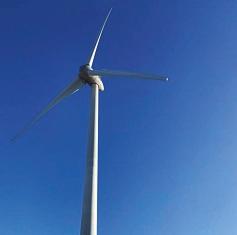
energyisequivalent to avoiding the carbon emissions from more than 136,759 cars on Irish roads, or theelectricity consumption of 528.8 millionsmartphones, recycling134,898 tonnes of waste instead of going to landfillor planting6.6 million trees. John Lynch, plant leader at Johnson& Johnson VisionCare Ireland UC,said theagreement was ‘a majorlandmarkonour journey in Ireland to achieve net zero carbonemissions by 2030and underlinesour commitment to ensuringabetter, healthier world’.
Floating wind turbinesaredesigned to bedeployedindeeper offshore waters, where wind resourcesarestrongerand more consistent. By utilising floating platforms, these turbines canbeinstalledinareas where traditional fixedbottomturbinesarenot feasible. This innovation expands the potential for windenergy generation,opening up vast offshoreareas for clean power production. In addition, positioning floating turbines much further off the coasthelps avoid conflictswiththose whoobject to theirimpact on coastalviews.


Karl findsinspiration for new ideas by researching what other countriesaredoing. He also uses creativity models.

SCAMPER isa creative thinking technique used to generatenew ideasandimprovements. Let’s work with Karl to apply each of theseven SCAMPER verbs.
Substitute
Replacethe object with anotherthingoridea. For example, Karl might considersubstituting traditional wind turbinedesigns with innovativealternativessuch as verticalaxis turbines. This couldhelpspace efficiency andbirdsafety
Combine
Usethe object with another at the sametime,e.g. hybrid vehicles. Hybridelectric vehiclesare powered by aninternal combustionengine(ICE)(i.e. the type of engine that wouldbe found ina petrolordiesel car) and anelectric motor, which usesenergystoredinbatteries.

Karl could use this concept to integrate wind turbines with solar panelsin hybrid renewableenergy systems to maximise energy productionandensure a more consistentpower supply.
Adapt
Usethe object inadifferent way.
Karl might adapt offshore wind turbines to make less undergroundnoiseso theimpact on marinelifeis minimised,ordesign smaller, more compactturbinessuitable for urbanareas with limitedspace.
Changethecharacteristics of the object.
Karl might consideradjustingbladedesigns to capture the mostenergyor useenergy storage systems for times when thereislittle wind.
Put to anotheruse
Utilise the object for adifferentpurpose.
Karl could consideralternativeapplications for windenergy. For example, wind turbines could power remote communities that finditdifficult to get electricity in traditional ways.
Remove anobject completely.
Karl explores thebenefits of removing theneed for a person to operateand maintain the wind turbine. Instead,it could communicateelectronically withtheengineering teamif repairs were needed. Thisisan example of lean manufacturing, which you learnedabout inChapter 2.
Use anobject inadifferent order thanis usuallydone.
Imagineif Karl reversed the traditional flow of windenergy. Instead of using wind to create energy, thinkabouttheidea of wind powered systems that couldhelp the fishing community to power theirboats.
Substitute
Suggestasubstitute for:
• A flower pot
• A pencilcase
• A ruler
Combine Whatwould you combinewith:
• A tennis racquet
• A flashlight
• A Christmastree?
Adapt
• A pair of jeans
• A soccer ball
• An oldbicycle
Modify
• A schoollocker
• Your coat
• A handrailbesideastairs
Put to anotheruse
• A paper bustimetable
• A lamp
• A pictureframe
Eliminate
Suggestanalternativeifthe followingitems were eliminated:
• A pen
• A doorbell
• Homewifi
Reverse
• A skateboard
• An automaticdoor
• A tablecloth
Electricity playsa crucial rolein powering variousaspects of our lives. It isneeded to power our homes,businesses,schoolsandhospitals. Butwhatexactly iselectricity?
Electricity isa form of energy. Everythingis made of atoms. All atoms contain positivelyandnegatively charged particles that move aroundeach other. Negatively charged particlesare called electrons. Positively charged particlesare called protons. Electrons can move between atoms. Positive charges repeleach other,asdonegative charges. A positive charge andanegative charge attract each other
We can use frictionorsunlight to separate chargesand cause positive charge to build up ononesideandnegative charge to build up on the otherside. For example,if you rubaglass rod with asilk cloth, positive charge accumulateson theglass rodandnegative charge accumulateson thesilk cloth. Also, whensunlight fallson a photovoltaic cell,negative charge builds up onone sideand positive charge builds up on the otherside. Then,if you connectthe positiveside to thenegativeside usinga conducting wire, the negativeelectrons will travel through the wire, from the positiveside to thenegativeside. That flow of electronsis calledanelectric current.
An electrical cellisadevice that converts chemicalenergyinto electricenergy. A batteryis made up of a collection of cells.
1. To power our homesandbusinesses,large amounts of electricity are generated using renewablesourcessuch as wind, thesun, water andbiomassornon-renewable sourcessuch as coaland fossil fuels.
2. Thiselectricity can thenbeharnessedand sent longdistances through transformers to anelectricalgrid. Theenergy createdissold to energysuppliers. Irelandhasseveral utility companies that provideelectricity.

3. Transmissionlineson tall towers carry electrical currents to substationsacross the country.

4. Distributionlines carry theelectricity to your area.
5. Electricity issent to your home. An electricity meter measures theamount of electricity your homeis using.

6. Electricity travels through wiringin your house to power all theswitches.
Some homesandbusinesseshave their ownsolar panels to generatesomeorall of theenergy they need. If they generate excessenergy, this canbesoldback to thegrid.
Karlneeds to choose materials wisely.
Materialshave the ability to conduct electricity, called conductivity Somematerialsare better conductors than others,e.g. copper is widely usedinelectrical wiringandsilverhas thehighestelectrical conductivity amongall metals.
Resistance isa material’sability to resist current flow.
Electricity canbeseeninnatureinabolt of lightning. It occurs because thereisanimbalance between twoareas that have oppositeelectrical charges. One of theseareasis usuallya cloud, and the otheris usually theground. When theelectrical charge ina cloudbecomes verystrong,it causesanopposite charge to build up onobjects on theground. When thedifferencein charges becomes toobig, we seea flash of lightning. Thisdischarge helps to balanceout the charges between the cloudand theground. Earthinghappens when this charge spreadsout so much that it effectivelydisappears.
An electric charge isa fundamental property of matter that determineshow particlesinteract with each other.

Method1
1. Tear up a piece of paper into sectionsonlya few centimetres across.
2. Take balloonandrubit against your hair to charge it.
3. Hold theballoon close to the pieces of paper andobserve what happens.
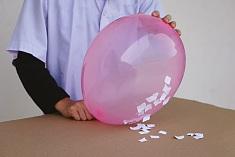
You should find that the pieces of paper are attracted upwards towards theballoon.
Method2
1. Placea plastic rodinastirrup suspended froma wooden retort stand,asshown.
2. Take asecond plastic rodandrubitagainst your hair to charge it.
3. Hold thesecond rod close to the firstoneandobserve what happens.
You should find that the first rodin thestirrup is attracted to thesecond rodin your hand.
Method3
1. Take a plastic rodandrubitagainst your hair to charge it.
2. Place the charged plastic rodinastirrup suspended from a wooden retortstand,asshown above.
3. Take asecond plastic rodandrubitagainst your hair to charge it.
4. Hold the two charged rods close to each otherandobserve what happens.

Observations
You should find that the two charged rods repeleach other.
Method4
1. Turnona tap so that thereisa gentlebut steady flow of water.

2. Take a plastic rodandrubitagainst your hair to charge it.
3. Hold the charged rod close to the water streamandobserve what happens.

Observations
You should find that thestream of water isdeflected by the presence of theelectric charge.
Hybridelectric vehiclesare powered by aninternal combustionengine(ICE),i.e. the type of engine that wouldbe found ina petrolordiesel car, andanelectric motor, which usesenergystoredina battery. Thebattery canbe charged through:
Regenerativebraking
This technology captures thekinetic energynormallylostduringbrakingand convertsitinto electricity, whichis then storedin the vehicle’s battery.
Electric charging
Pluggingitin to anelectric charging point.
Internal combustion engine
The extra power provided by the electric motor canallow for asmaller engine. Together, these features resultinbetter fueleconomy without sacrificing performance.
Thereare many benefits of using hybrid vehiclesin urban transport,including:
• Reducedharmful emissions
• Much lessnoiseandsound pollution
• Efficiency for shorter trips
• Regenerative braking technology.


Full hybrids
The most fuel efficient hybrid vehiclesare more expensive than mild hybrids. They have alarger batteryand more powerful electric motors, resultinginbetter fueleconomy benefits. They canoperatein:
• Allelectric mode(implies the car isrunning fully onelectricity andissuitable for low speeds)
• Series mode(implies the theelectric motor is driving the wheelsbuttheICEis used at the sametimeasonboard generator)
• Parallel mode, which uses theelectric motor and ICE to drive the wheels.
Mildormicro hybrids
Mildor micro hybridsarelimited to operatingin parallel mode. They have anelectric motor that lacks the power to drive the wheels at asignificant speed without help from theinternal combustion engine(ICE). These hybrids usually come equipped with automaticstop-startand regenerative braking features to improve fueleconomy.
However, they arenot as efficient as full hybrids in terms of kilometres per kilowatthour (kWh). While they useabatteryandelectric motor to help in powering the vehicle, they cannot solely relyon electricity to drive. Mildor micro hybridsareless expensive than full hybridsbutprovidelower fuel economy.
• They arenot as efficient asa full hybridin terms of kilometres per kilowatthour (kWh).
• They useabatteryandelectric motor to help power the vehicle, butcan’tpower the vehicle using electricity alone.
• They costless than full hybrids.

• They provideless fueleconomy than full hybrids.
Plug-in hybrids
Plug-in hybridsare vehicles that can be recharged by plugging theminto anelectricoutlet. They have both a conventionalinternal combustion engine(ICE)andlarger batteries compared to regular hybrids. This allows them to drivelongerdistances usingelectric power.
Vehicle ownership
The cost of hybrid vehiclesishigher than traditional petrolordiesel cars. However, the government wants to encourage people to buy more sustainable vehicles,so there may be grants or tax reliefs available.
If the technologyinself-driving cars continues to advance, then we can expect to seeadecreasein ownership– why would peopleneed their own car if they can pushabuttononanapp andaself-driving car appears at theirdoor?
Environmentalimpact
Hybrid cars are much, much better for the environmentthandieselor petrol cars In particular, since more of Ireland’selectricity isnow sourced from wind,electric powered hybrid cars truly can make ahuge difference. Also,sinceelectric vehicles arequieter, they causesignificantlylessnoise pollution.

Vehicle maintenance

Hybrid cars canbe costly to maintainandservice. TheICE,battery pack and traction motor allneed regular maintenance. Specialised mechanicsarein growingdemandso that they can perform these tasksas wellasidentify any specific issues. Scan the QR codebelow to findoutmore aboutthe benefits of hybrid technologyin Toyotacars.
Contrary to popularbelief, mechanicalengineeringis far more thantinkering with enginesingrimy environments or tacklingheavyduty jobs. In reality, mechanicalengineersenjoy adiverse range of career paths,includingsportsengineering, processimprovement,manufacturingengineering, constructionengineeringandinnovationengineering.
Thescope of work for mechanicalengineers variesdepending on theirdepartment and role. Whilesome may engageinhandson taskssuch as working with engines, others focus ondesigning products and processes using computeraided tools. This profession offersa multitude of opportunitiesbeyond traditionalnotions of enginesand machines.

What was your education journey to where you are today?
Igraduated with a MSc degreeinCivil, Structuraland Environmental Engineering from Poznan University of Technology, Polandin1999.I completeda Certificate and Diplomain Local Government Studies from the Institute of Public Administration,and a Certificate in Road Programme ManagementfromCarlow IT (now part of South East Technological University).
What would you say to your 16-year-old self?
Seekout advice from peoplein theindustryasearlyas possible– this willhelp you to understand what isinvolvedinbeinganengineer.
Where did your passion for engineering come from?
Engineering wasalwaysin the family. My fatherisa retiredengineer. My mother worked in chemistrylaboratoriesanda roadand materials testinglaboratory.
What does a typical work day involve for you?
Today I workin Cork County Councilin roaddesign.Ispendtimedesigning roadlayouts, checking themagainst the current standardsand makingsure thesolutionsaresafe for all road users.I create planningand technicaldocuments for public consultation processesandsometimesI presentthose to the public andelected members.I make tenderdocuments to procure contractors for the works.Iquantify worksandestimate the cost of project delivery to inform thesenior management andapprove thebudget. Everyday isdifferent.
Name: Jerry Ó Mathúnaand Alex Ó Ríordáin
School: Colaiste Choilm, Ballincollig, Co. Cork
Project: Investigation intothe optimum design of heat pump fan technology for the Irish climate
Aboutthe project: We wanted to base our project on a sustainable heating system that would benefittheenvironment. We did a lot of research on heat pumps anddid experimentstosee if we could improve on theefficiency of heat pumps in Ireland. We came up with an idea on heat pump fan design anddecided to build a prototype. Through testing and analysing the results we discovered that our design would be more efficient for the Irish climate over a full year We learned through this projectthat hard problems can be solved withscientific analysis We thoroughly enjoyed working on this project. It was a great experience going tothe RDS and presenting our projecttothe judges and tothe public We also learned many technical skills, e.g. how to measure the airflowof a fan using ananemometer, as well as how to communicate our findings and make presentations. It really helpedbuild our confidence.

1 Identify how muchwindenergyis contributing to electricity production in Ireland.


2 Explain,in your own words,how electricity is produced.
3 Outline two ways to determine the presence of anelectric charge.
4 Illustrate how lightninghappens.
5 Describehow a wind turbine generateselectricity.
6 Writedowntwoadvantagesand two challenges ofoffshore wind generationin Ireland today.
7 Distinguishbetween thedifferent letters of the SCAMPER technique andapply eachone to an everyday object in yourclassroom today.
Answer(A)or(B)below.
A Lightningisanaturallyoccuringelectrostatic discharge. It is caused by animbalancebetween twoelectrically charged regions, usuallya cloudand theground.As charge builds up ona cloud, the cloudinduces a charge onobjects on theground. Explain, withtheaid of alabelled diagram, what happens whenlightningstrikes theearth.
BOffshore windenergyisagrowing form of renewableenergyaround the coast of Ireland.
(i) Describe, withtheaid of adiagram,how turbines convert wind energyinto electricalenergy.







(ii) Findoutwhich countrieshave achievedsignificant successin wind energy production. What lessons can Irelandlearn from their experiences?

Become aware of ways that individuals,schoolsand companiesarebecoming more environmentally friendly. Look for smart meters,solar panels, charging points for electric vehicles, etc. Note themdown in your Observation Journal.
1 Insights on windenergy usein Irelandanditsimpact on climate change.
2 A debate about how differentmembers of the community might feelabout a windfarmin theirlocalarea.
3 A list of:
• Topthreesources of energyin Ireland


• The average price of electricity in Ireland
• The average yearlybill that households pay in Ireland today
• Theannual percentage difference.
4 A table of data regarding Ireland’s, Norway’s and Brazil’s current,historic and projected use of fossil fuels.
5 A pie chartillustrating theamount of windenergyinstalledin Republic of Irelandand Northern Ireland.
6 A list of suggestionsaround thinking creatively withthe following prompts:
• Substitute
• Combine
• Adapt
• Modify
• Put to another use
• Eliminate
• Reverse.